Understanding and Leading Change in Organizational Contexts
VerifiedAdded on 2024/04/25
|18
|5429
|297
AI Summary
This report explores the impact of change on organizational strategies, leadership decision-making, and behavior. It evaluates measures to minimize negative impacts and applies various leadership approaches for effective change management.
Contribute Materials
Your contribution can guide someone’s learning journey. Share your
documents today.
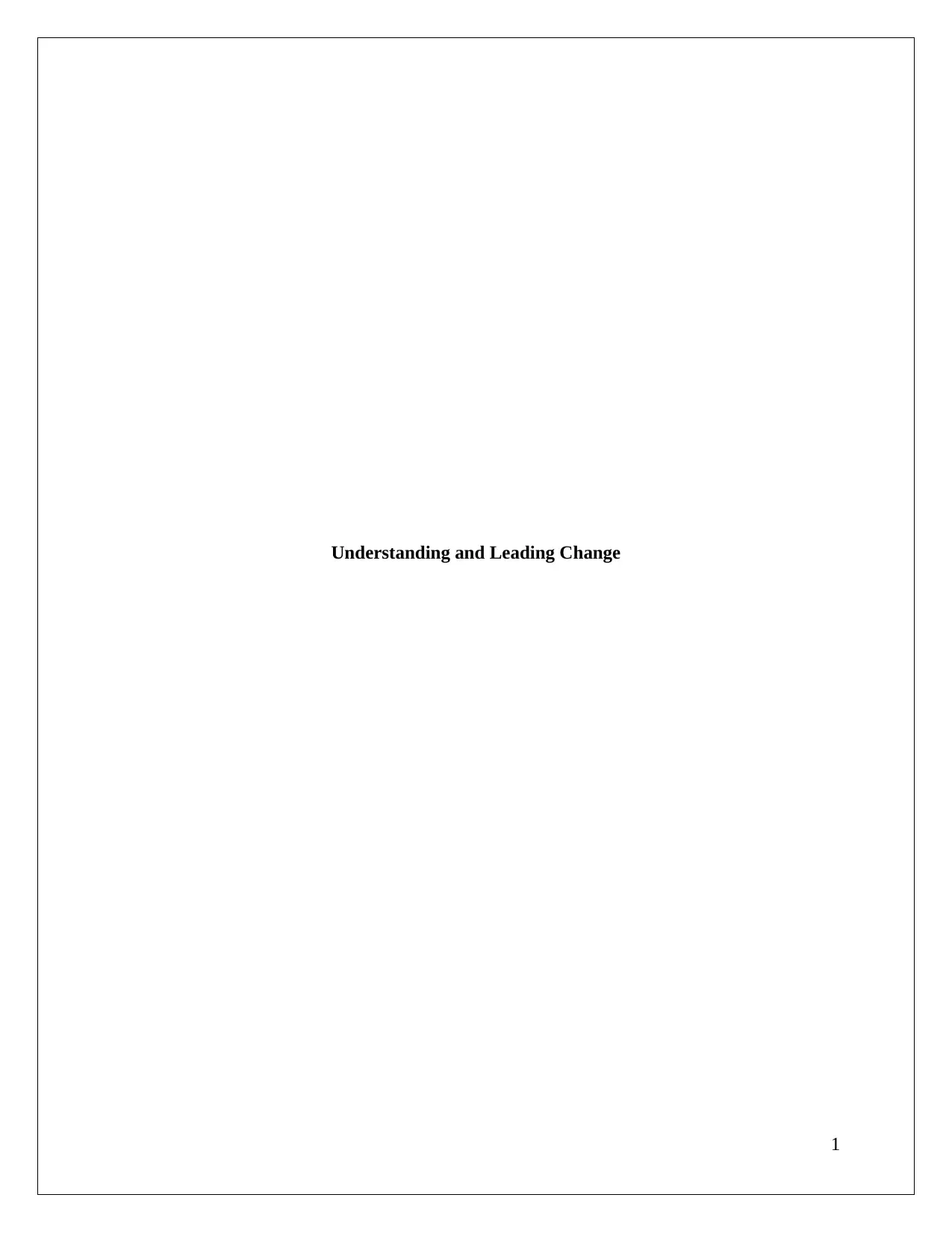
Understanding and Leading Change
1
1
Secure Best Marks with AI Grader
Need help grading? Try our AI Grader for instant feedback on your assignments.
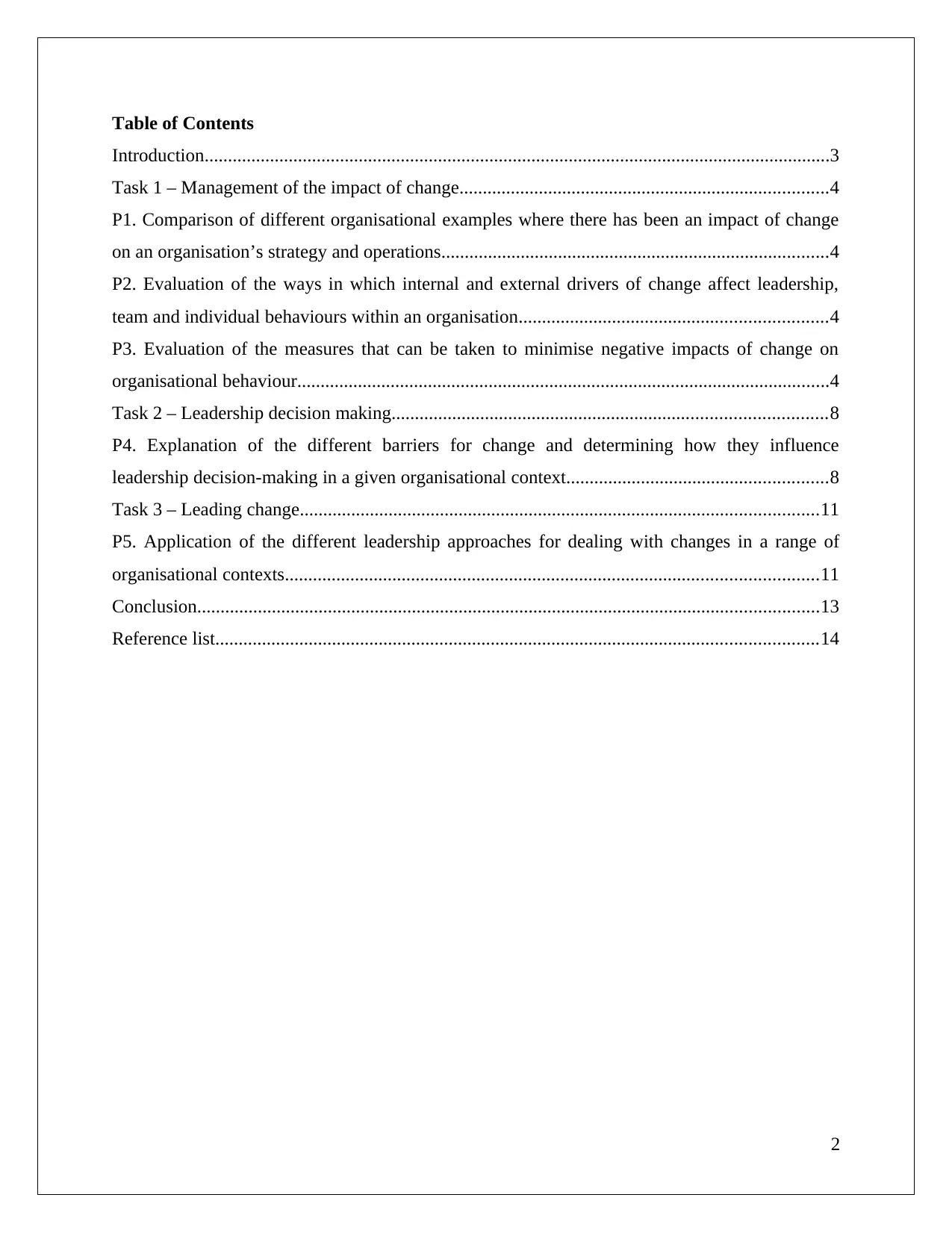
Table of Contents
Introduction......................................................................................................................................3
Task 1 – Management of the impact of change...............................................................................4
P1. Comparison of different organisational examples where there has been an impact of change
on an organisation’s strategy and operations...................................................................................4
P2. Evaluation of the ways in which internal and external drivers of change affect leadership,
team and individual behaviours within an organisation..................................................................4
P3. Evaluation of the measures that can be taken to minimise negative impacts of change on
organisational behaviour..................................................................................................................4
Task 2 – Leadership decision making.............................................................................................8
P4. Explanation of the different barriers for change and determining how they influence
leadership decision-making in a given organisational context........................................................8
Task 3 – Leading change...............................................................................................................11
P5. Application of the different leadership approaches for dealing with changes in a range of
organisational contexts..................................................................................................................11
Conclusion.....................................................................................................................................13
Reference list.................................................................................................................................14
2
Introduction......................................................................................................................................3
Task 1 – Management of the impact of change...............................................................................4
P1. Comparison of different organisational examples where there has been an impact of change
on an organisation’s strategy and operations...................................................................................4
P2. Evaluation of the ways in which internal and external drivers of change affect leadership,
team and individual behaviours within an organisation..................................................................4
P3. Evaluation of the measures that can be taken to minimise negative impacts of change on
organisational behaviour..................................................................................................................4
Task 2 – Leadership decision making.............................................................................................8
P4. Explanation of the different barriers for change and determining how they influence
leadership decision-making in a given organisational context........................................................8
Task 3 – Leading change...............................................................................................................11
P5. Application of the different leadership approaches for dealing with changes in a range of
organisational contexts..................................................................................................................11
Conclusion.....................................................................................................................................13
Reference list.................................................................................................................................14
2
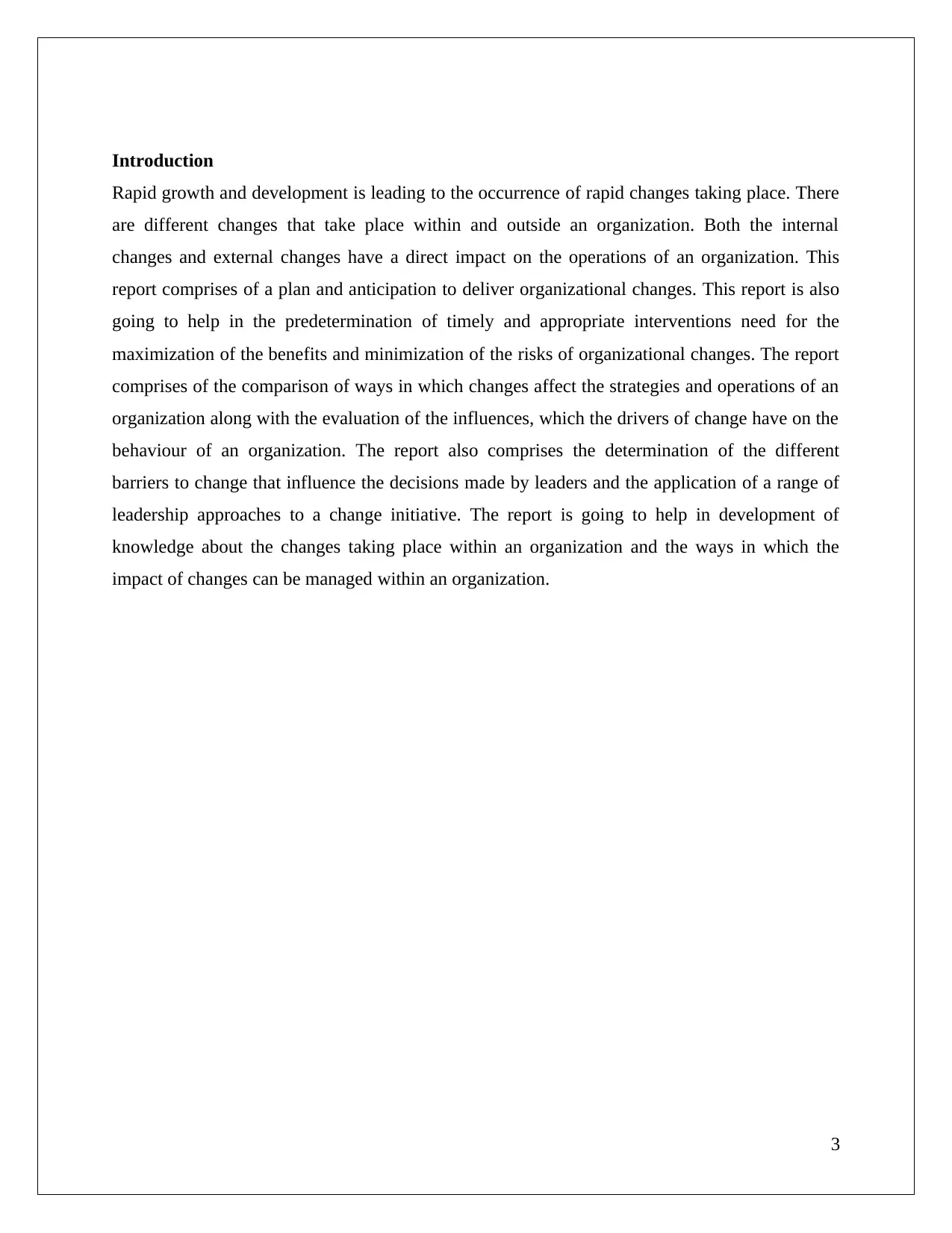
Introduction
Rapid growth and development is leading to the occurrence of rapid changes taking place. There
are different changes that take place within and outside an organization. Both the internal
changes and external changes have a direct impact on the operations of an organization. This
report comprises of a plan and anticipation to deliver organizational changes. This report is also
going to help in the predetermination of timely and appropriate interventions need for the
maximization of the benefits and minimization of the risks of organizational changes. The report
comprises of the comparison of ways in which changes affect the strategies and operations of an
organization along with the evaluation of the influences, which the drivers of change have on the
behaviour of an organization. The report also comprises the determination of the different
barriers to change that influence the decisions made by leaders and the application of a range of
leadership approaches to a change initiative. The report is going to help in development of
knowledge about the changes taking place within an organization and the ways in which the
impact of changes can be managed within an organization.
3
Rapid growth and development is leading to the occurrence of rapid changes taking place. There
are different changes that take place within and outside an organization. Both the internal
changes and external changes have a direct impact on the operations of an organization. This
report comprises of a plan and anticipation to deliver organizational changes. This report is also
going to help in the predetermination of timely and appropriate interventions need for the
maximization of the benefits and minimization of the risks of organizational changes. The report
comprises of the comparison of ways in which changes affect the strategies and operations of an
organization along with the evaluation of the influences, which the drivers of change have on the
behaviour of an organization. The report also comprises the determination of the different
barriers to change that influence the decisions made by leaders and the application of a range of
leadership approaches to a change initiative. The report is going to help in development of
knowledge about the changes taking place within an organization and the ways in which the
impact of changes can be managed within an organization.
3
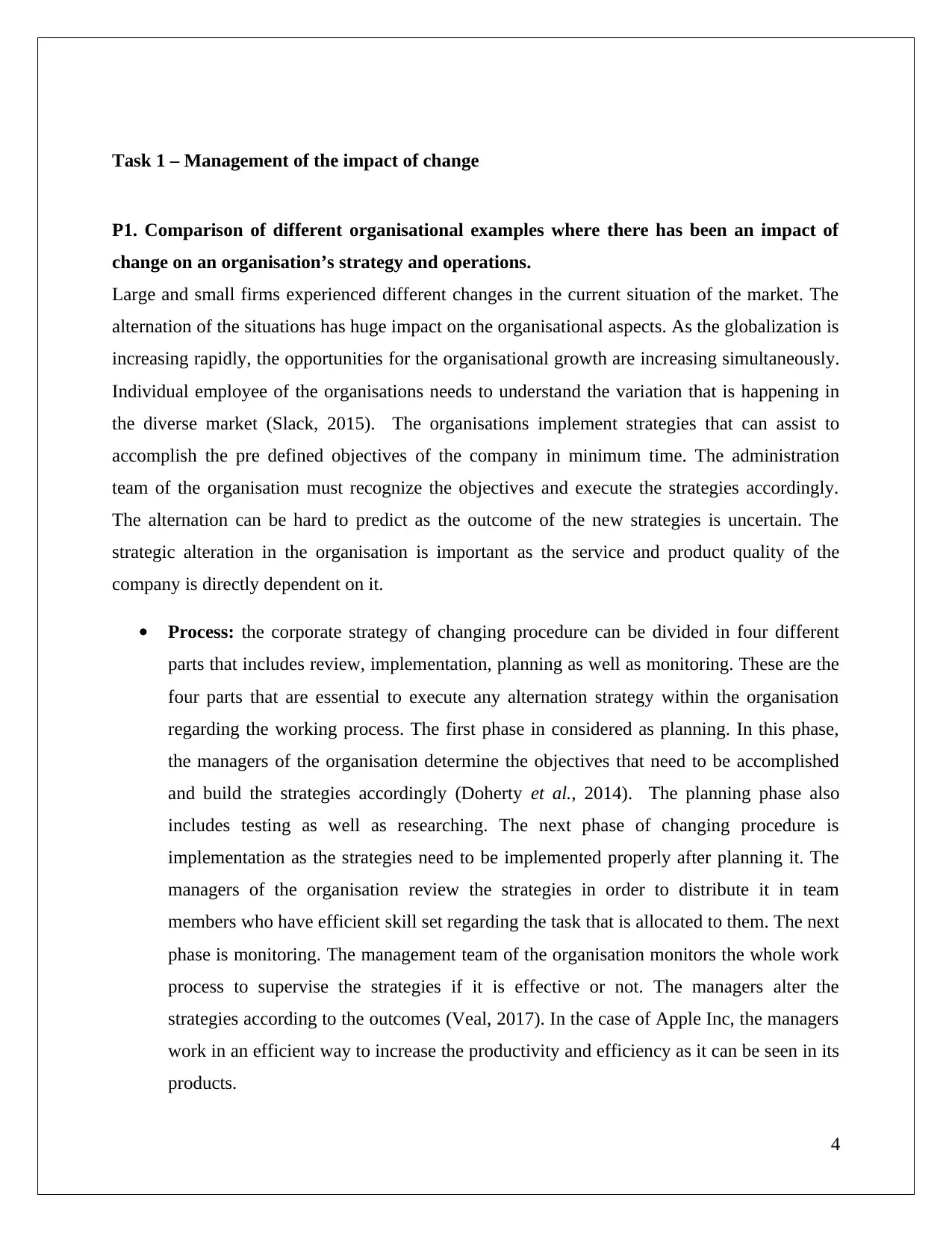
Task 1 – Management of the impact of change
P1. Comparison of different organisational examples where there has been an impact of
change on an organisation’s strategy and operations.
Large and small firms experienced different changes in the current situation of the market. The
alternation of the situations has huge impact on the organisational aspects. As the globalization is
increasing rapidly, the opportunities for the organisational growth are increasing simultaneously.
Individual employee of the organisations needs to understand the variation that is happening in
the diverse market (Slack, 2015). The organisations implement strategies that can assist to
accomplish the pre defined objectives of the company in minimum time. The administration
team of the organisation must recognize the objectives and execute the strategies accordingly.
The alternation can be hard to predict as the outcome of the new strategies is uncertain. The
strategic alteration in the organisation is important as the service and product quality of the
company is directly dependent on it.
Process: the corporate strategy of changing procedure can be divided in four different
parts that includes review, implementation, planning as well as monitoring. These are the
four parts that are essential to execute any alternation strategy within the organisation
regarding the working process. The first phase in considered as planning. In this phase,
the managers of the organisation determine the objectives that need to be accomplished
and build the strategies accordingly (Doherty et al., 2014). The planning phase also
includes testing as well as researching. The next phase of changing procedure is
implementation as the strategies need to be implemented properly after planning it. The
managers of the organisation review the strategies in order to distribute it in team
members who have efficient skill set regarding the task that is allocated to them. The next
phase is monitoring. The management team of the organisation monitors the whole work
process to supervise the strategies if it is effective or not. The managers alter the
strategies according to the outcomes (Veal, 2017). In the case of Apple Inc, the managers
work in an efficient way to increase the productivity and efficiency as it can be seen in its
products.
4
P1. Comparison of different organisational examples where there has been an impact of
change on an organisation’s strategy and operations.
Large and small firms experienced different changes in the current situation of the market. The
alternation of the situations has huge impact on the organisational aspects. As the globalization is
increasing rapidly, the opportunities for the organisational growth are increasing simultaneously.
Individual employee of the organisations needs to understand the variation that is happening in
the diverse market (Slack, 2015). The organisations implement strategies that can assist to
accomplish the pre defined objectives of the company in minimum time. The administration
team of the organisation must recognize the objectives and execute the strategies accordingly.
The alternation can be hard to predict as the outcome of the new strategies is uncertain. The
strategic alteration in the organisation is important as the service and product quality of the
company is directly dependent on it.
Process: the corporate strategy of changing procedure can be divided in four different
parts that includes review, implementation, planning as well as monitoring. These are the
four parts that are essential to execute any alternation strategy within the organisation
regarding the working process. The first phase in considered as planning. In this phase,
the managers of the organisation determine the objectives that need to be accomplished
and build the strategies accordingly (Doherty et al., 2014). The planning phase also
includes testing as well as researching. The next phase of changing procedure is
implementation as the strategies need to be implemented properly after planning it. The
managers of the organisation review the strategies in order to distribute it in team
members who have efficient skill set regarding the task that is allocated to them. The next
phase is monitoring. The management team of the organisation monitors the whole work
process to supervise the strategies if it is effective or not. The managers alter the
strategies according to the outcomes (Veal, 2017). In the case of Apple Inc, the managers
work in an efficient way to increase the productivity and efficiency as it can be seen in its
products.
4
Secure Best Marks with AI Grader
Need help grading? Try our AI Grader for instant feedback on your assignments.
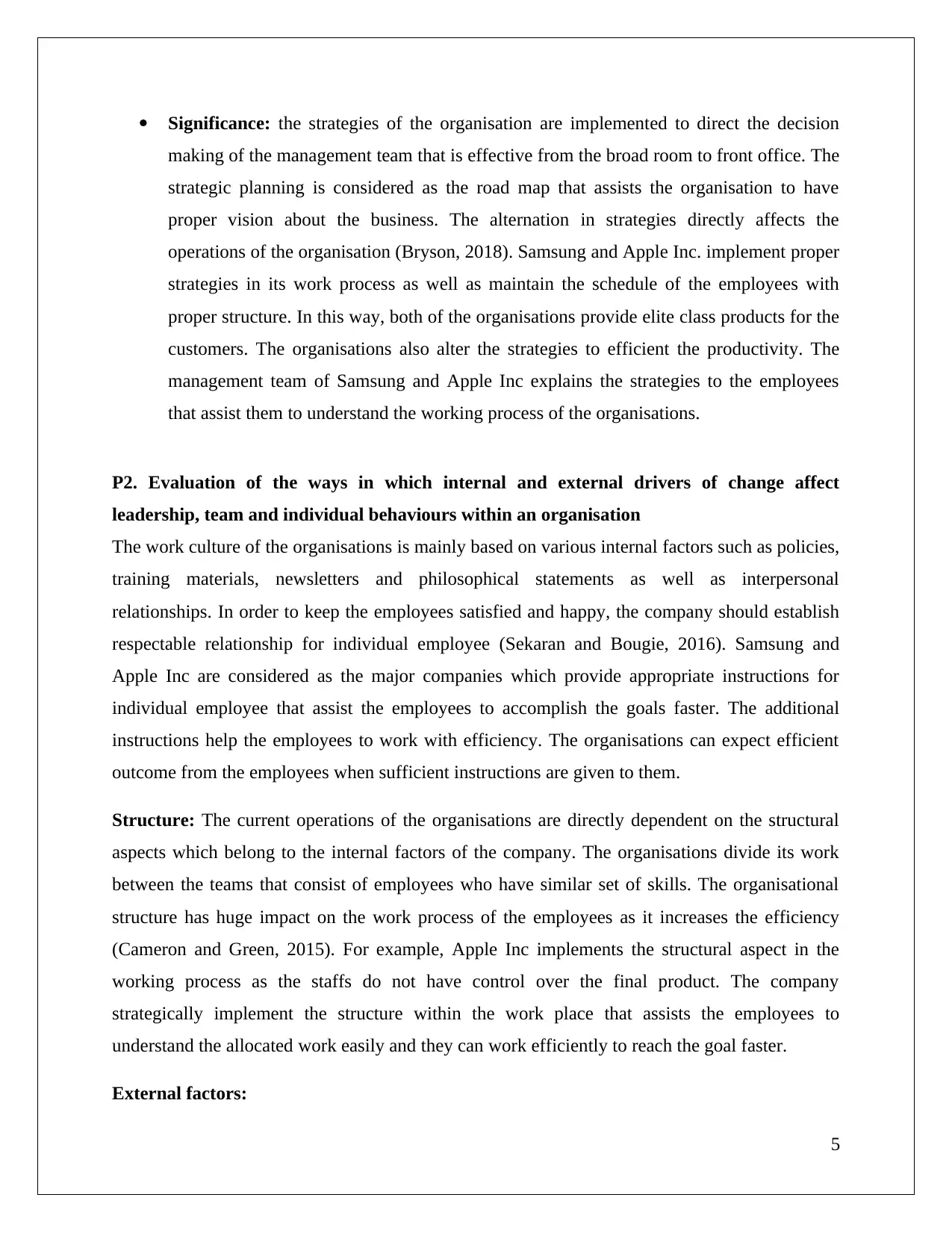
Significance: the strategies of the organisation are implemented to direct the decision
making of the management team that is effective from the broad room to front office. The
strategic planning is considered as the road map that assists the organisation to have
proper vision about the business. The alternation in strategies directly affects the
operations of the organisation (Bryson, 2018). Samsung and Apple Inc. implement proper
strategies in its work process as well as maintain the schedule of the employees with
proper structure. In this way, both of the organisations provide elite class products for the
customers. The organisations also alter the strategies to efficient the productivity. The
management team of Samsung and Apple Inc explains the strategies to the employees
that assist them to understand the working process of the organisations.
P2. Evaluation of the ways in which internal and external drivers of change affect
leadership, team and individual behaviours within an organisation
The work culture of the organisations is mainly based on various internal factors such as policies,
training materials, newsletters and philosophical statements as well as interpersonal
relationships. In order to keep the employees satisfied and happy, the company should establish
respectable relationship for individual employee (Sekaran and Bougie, 2016). Samsung and
Apple Inc are considered as the major companies which provide appropriate instructions for
individual employee that assist the employees to accomplish the goals faster. The additional
instructions help the employees to work with efficiency. The organisations can expect efficient
outcome from the employees when sufficient instructions are given to them.
Structure: The current operations of the organisations are directly dependent on the structural
aspects which belong to the internal factors of the company. The organisations divide its work
between the teams that consist of employees who have similar set of skills. The organisational
structure has huge impact on the work process of the employees as it increases the efficiency
(Cameron and Green, 2015). For example, Apple Inc implements the structural aspect in the
working process as the staffs do not have control over the final product. The company
strategically implement the structure within the work place that assists the employees to
understand the allocated work easily and they can work efficiently to reach the goal faster.
External factors:
5
making of the management team that is effective from the broad room to front office. The
strategic planning is considered as the road map that assists the organisation to have
proper vision about the business. The alternation in strategies directly affects the
operations of the organisation (Bryson, 2018). Samsung and Apple Inc. implement proper
strategies in its work process as well as maintain the schedule of the employees with
proper structure. In this way, both of the organisations provide elite class products for the
customers. The organisations also alter the strategies to efficient the productivity. The
management team of Samsung and Apple Inc explains the strategies to the employees
that assist them to understand the working process of the organisations.
P2. Evaluation of the ways in which internal and external drivers of change affect
leadership, team and individual behaviours within an organisation
The work culture of the organisations is mainly based on various internal factors such as policies,
training materials, newsletters and philosophical statements as well as interpersonal
relationships. In order to keep the employees satisfied and happy, the company should establish
respectable relationship for individual employee (Sekaran and Bougie, 2016). Samsung and
Apple Inc are considered as the major companies which provide appropriate instructions for
individual employee that assist the employees to accomplish the goals faster. The additional
instructions help the employees to work with efficiency. The organisations can expect efficient
outcome from the employees when sufficient instructions are given to them.
Structure: The current operations of the organisations are directly dependent on the structural
aspects which belong to the internal factors of the company. The organisations divide its work
between the teams that consist of employees who have similar set of skills. The organisational
structure has huge impact on the work process of the employees as it increases the efficiency
(Cameron and Green, 2015). For example, Apple Inc implements the structural aspect in the
working process as the staffs do not have control over the final product. The company
strategically implement the structure within the work place that assists the employees to
understand the allocated work easily and they can work efficiently to reach the goal faster.
External factors:
5
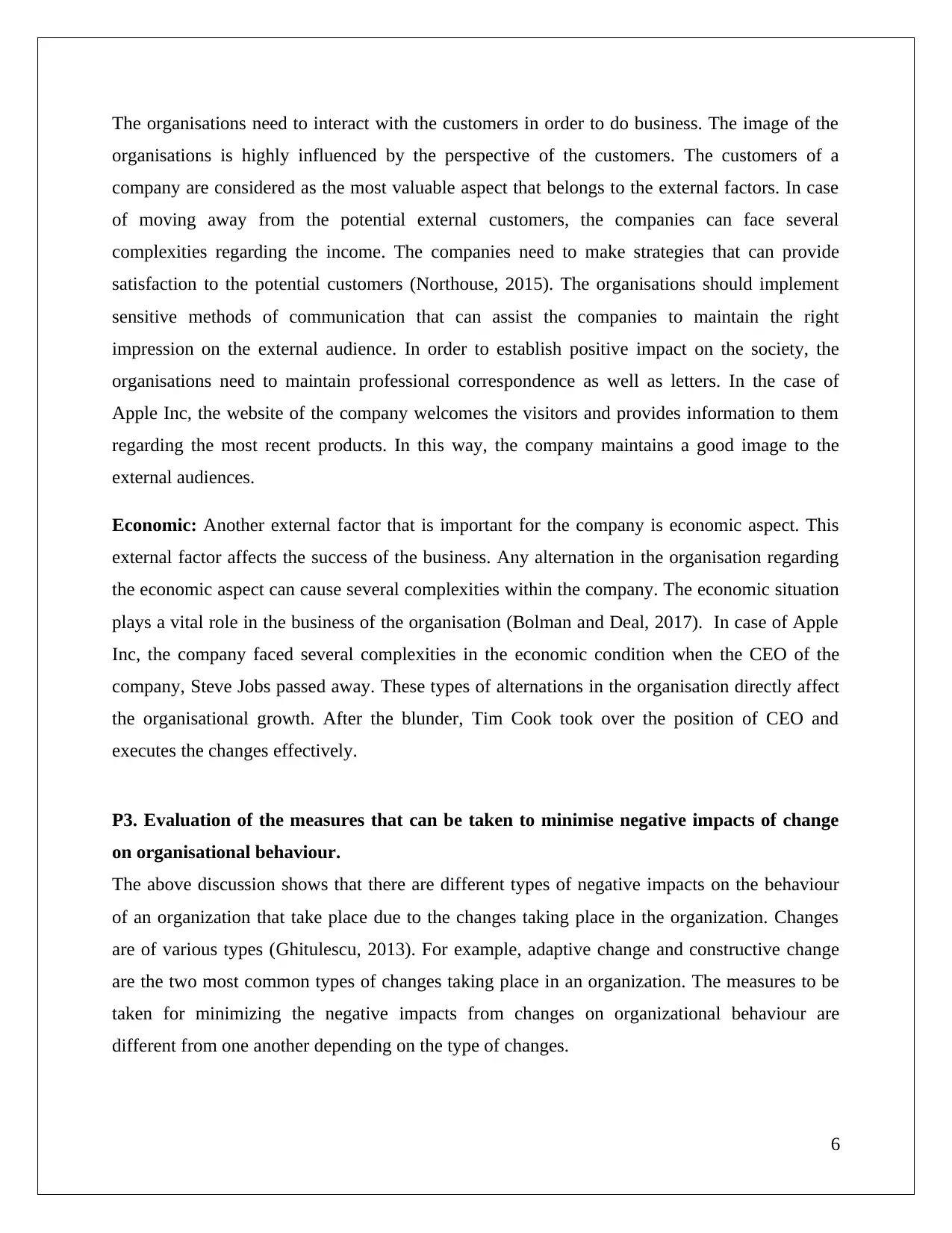
The organisations need to interact with the customers in order to do business. The image of the
organisations is highly influenced by the perspective of the customers. The customers of a
company are considered as the most valuable aspect that belongs to the external factors. In case
of moving away from the potential external customers, the companies can face several
complexities regarding the income. The companies need to make strategies that can provide
satisfaction to the potential customers (Northouse, 2015). The organisations should implement
sensitive methods of communication that can assist the companies to maintain the right
impression on the external audience. In order to establish positive impact on the society, the
organisations need to maintain professional correspondence as well as letters. In the case of
Apple Inc, the website of the company welcomes the visitors and provides information to them
regarding the most recent products. In this way, the company maintains a good image to the
external audiences.
Economic: Another external factor that is important for the company is economic aspect. This
external factor affects the success of the business. Any alternation in the organisation regarding
the economic aspect can cause several complexities within the company. The economic situation
plays a vital role in the business of the organisation (Bolman and Deal, 2017). In case of Apple
Inc, the company faced several complexities in the economic condition when the CEO of the
company, Steve Jobs passed away. These types of alternations in the organisation directly affect
the organisational growth. After the blunder, Tim Cook took over the position of CEO and
executes the changes effectively.
P3. Evaluation of the measures that can be taken to minimise negative impacts of change
on organisational behaviour.
The above discussion shows that there are different types of negative impacts on the behaviour
of an organization that take place due to the changes taking place in the organization. Changes
are of various types (Ghitulescu, 2013). For example, adaptive change and constructive change
are the two most common types of changes taking place in an organization. The measures to be
taken for minimizing the negative impacts from changes on organizational behaviour are
different from one another depending on the type of changes.
6
organisations is highly influenced by the perspective of the customers. The customers of a
company are considered as the most valuable aspect that belongs to the external factors. In case
of moving away from the potential external customers, the companies can face several
complexities regarding the income. The companies need to make strategies that can provide
satisfaction to the potential customers (Northouse, 2015). The organisations should implement
sensitive methods of communication that can assist the companies to maintain the right
impression on the external audience. In order to establish positive impact on the society, the
organisations need to maintain professional correspondence as well as letters. In the case of
Apple Inc, the website of the company welcomes the visitors and provides information to them
regarding the most recent products. In this way, the company maintains a good image to the
external audiences.
Economic: Another external factor that is important for the company is economic aspect. This
external factor affects the success of the business. Any alternation in the organisation regarding
the economic aspect can cause several complexities within the company. The economic situation
plays a vital role in the business of the organisation (Bolman and Deal, 2017). In case of Apple
Inc, the company faced several complexities in the economic condition when the CEO of the
company, Steve Jobs passed away. These types of alternations in the organisation directly affect
the organisational growth. After the blunder, Tim Cook took over the position of CEO and
executes the changes effectively.
P3. Evaluation of the measures that can be taken to minimise negative impacts of change
on organisational behaviour.
The above discussion shows that there are different types of negative impacts on the behaviour
of an organization that take place due to the changes taking place in the organization. Changes
are of various types (Ghitulescu, 2013). For example, adaptive change and constructive change
are the two most common types of changes taking place in an organization. The measures to be
taken for minimizing the negative impacts from changes on organizational behaviour are
different from one another depending on the type of changes.
6
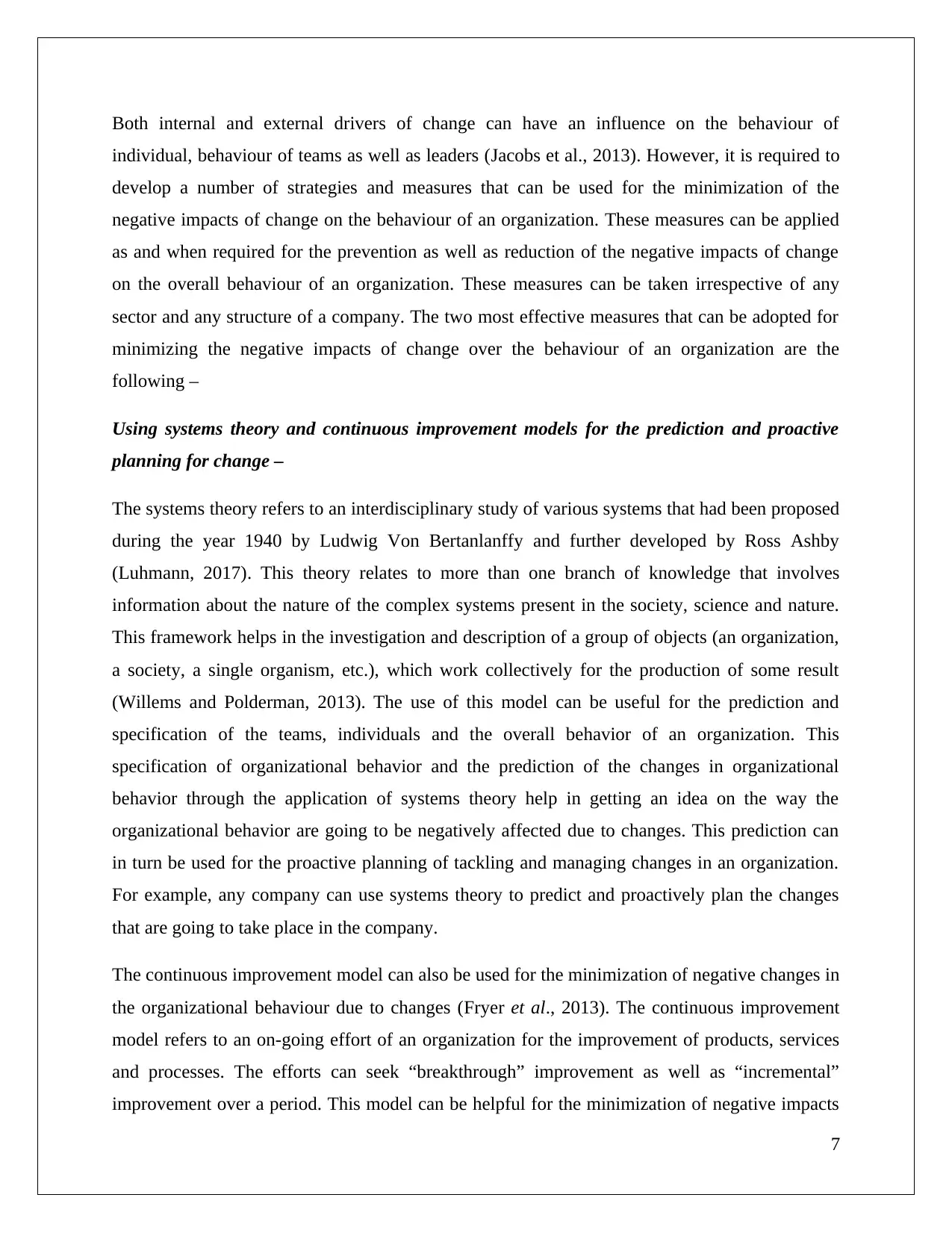
Both internal and external drivers of change can have an influence on the behaviour of
individual, behaviour of teams as well as leaders (Jacobs et al., 2013). However, it is required to
develop a number of strategies and measures that can be used for the minimization of the
negative impacts of change on the behaviour of an organization. These measures can be applied
as and when required for the prevention as well as reduction of the negative impacts of change
on the overall behaviour of an organization. These measures can be taken irrespective of any
sector and any structure of a company. The two most effective measures that can be adopted for
minimizing the negative impacts of change over the behaviour of an organization are the
following –
Using systems theory and continuous improvement models for the prediction and proactive
planning for change –
The systems theory refers to an interdisciplinary study of various systems that had been proposed
during the year 1940 by Ludwig Von Bertanlanffy and further developed by Ross Ashby
(Luhmann, 2017). This theory relates to more than one branch of knowledge that involves
information about the nature of the complex systems present in the society, science and nature.
This framework helps in the investigation and description of a group of objects (an organization,
a society, a single organism, etc.), which work collectively for the production of some result
(Willems and Polderman, 2013). The use of this model can be useful for the prediction and
specification of the teams, individuals and the overall behavior of an organization. This
specification of organizational behavior and the prediction of the changes in organizational
behavior through the application of systems theory help in getting an idea on the way the
organizational behavior are going to be negatively affected due to changes. This prediction can
in turn be used for the proactive planning of tackling and managing changes in an organization.
For example, any company can use systems theory to predict and proactively plan the changes
that are going to take place in the company.
The continuous improvement model can also be used for the minimization of negative changes in
the organizational behaviour due to changes (Fryer et al., 2013). The continuous improvement
model refers to an on-going effort of an organization for the improvement of products, services
and processes. The efforts can seek “breakthrough” improvement as well as “incremental”
improvement over a period. This model can be helpful for the minimization of negative impacts
7
individual, behaviour of teams as well as leaders (Jacobs et al., 2013). However, it is required to
develop a number of strategies and measures that can be used for the minimization of the
negative impacts of change on the behaviour of an organization. These measures can be applied
as and when required for the prevention as well as reduction of the negative impacts of change
on the overall behaviour of an organization. These measures can be taken irrespective of any
sector and any structure of a company. The two most effective measures that can be adopted for
minimizing the negative impacts of change over the behaviour of an organization are the
following –
Using systems theory and continuous improvement models for the prediction and proactive
planning for change –
The systems theory refers to an interdisciplinary study of various systems that had been proposed
during the year 1940 by Ludwig Von Bertanlanffy and further developed by Ross Ashby
(Luhmann, 2017). This theory relates to more than one branch of knowledge that involves
information about the nature of the complex systems present in the society, science and nature.
This framework helps in the investigation and description of a group of objects (an organization,
a society, a single organism, etc.), which work collectively for the production of some result
(Willems and Polderman, 2013). The use of this model can be useful for the prediction and
specification of the teams, individuals and the overall behavior of an organization. This
specification of organizational behavior and the prediction of the changes in organizational
behavior through the application of systems theory help in getting an idea on the way the
organizational behavior are going to be negatively affected due to changes. This prediction can
in turn be used for the proactive planning of tackling and managing changes in an organization.
For example, any company can use systems theory to predict and proactively plan the changes
that are going to take place in the company.
The continuous improvement model can also be used for the minimization of negative changes in
the organizational behaviour due to changes (Fryer et al., 2013). The continuous improvement
model refers to an on-going effort of an organization for the improvement of products, services
and processes. The efforts can seek “breakthrough” improvement as well as “incremental”
improvement over a period. This model can be helpful for the minimization of negative impacts
7
Paraphrase This Document
Need a fresh take? Get an instant paraphrase of this document with our AI Paraphraser
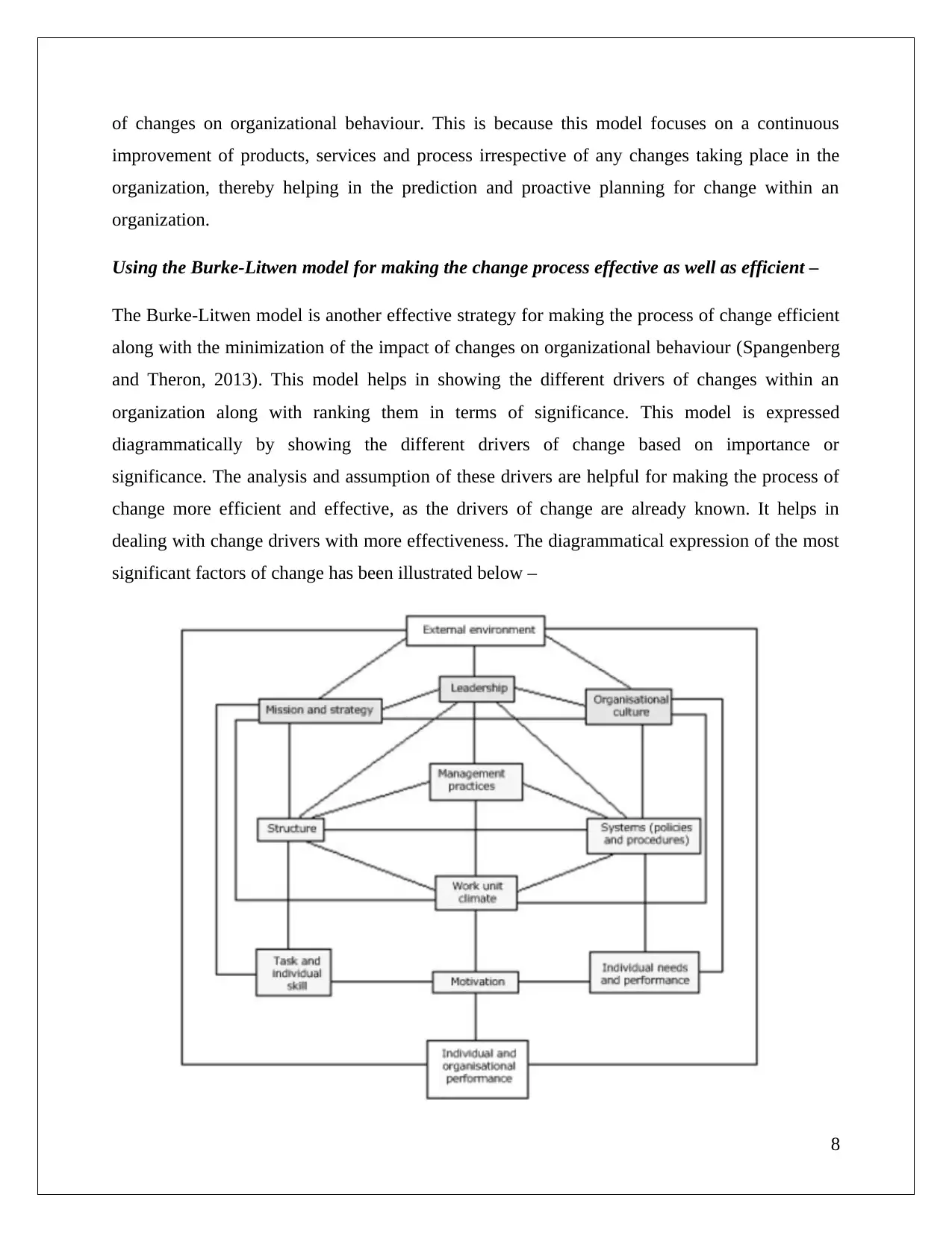
of changes on organizational behaviour. This is because this model focuses on a continuous
improvement of products, services and process irrespective of any changes taking place in the
organization, thereby helping in the prediction and proactive planning for change within an
organization.
Using the Burke-Litwen model for making the change process effective as well as efficient –
The Burke-Litwen model is another effective strategy for making the process of change efficient
along with the minimization of the impact of changes on organizational behaviour (Spangenberg
and Theron, 2013). This model helps in showing the different drivers of changes within an
organization along with ranking them in terms of significance. This model is expressed
diagrammatically by showing the different drivers of change based on importance or
significance. The analysis and assumption of these drivers are helpful for making the process of
change more efficient and effective, as the drivers of change are already known. It helps in
dealing with change drivers with more effectiveness. The diagrammatical expression of the most
significant factors of change has been illustrated below –
8
improvement of products, services and process irrespective of any changes taking place in the
organization, thereby helping in the prediction and proactive planning for change within an
organization.
Using the Burke-Litwen model for making the change process effective as well as efficient –
The Burke-Litwen model is another effective strategy for making the process of change efficient
along with the minimization of the impact of changes on organizational behaviour (Spangenberg
and Theron, 2013). This model helps in showing the different drivers of changes within an
organization along with ranking them in terms of significance. This model is expressed
diagrammatically by showing the different drivers of change based on importance or
significance. The analysis and assumption of these drivers are helpful for making the process of
change more efficient and effective, as the drivers of change are already known. It helps in
dealing with change drivers with more effectiveness. The diagrammatical expression of the most
significant factors of change has been illustrated below –
8
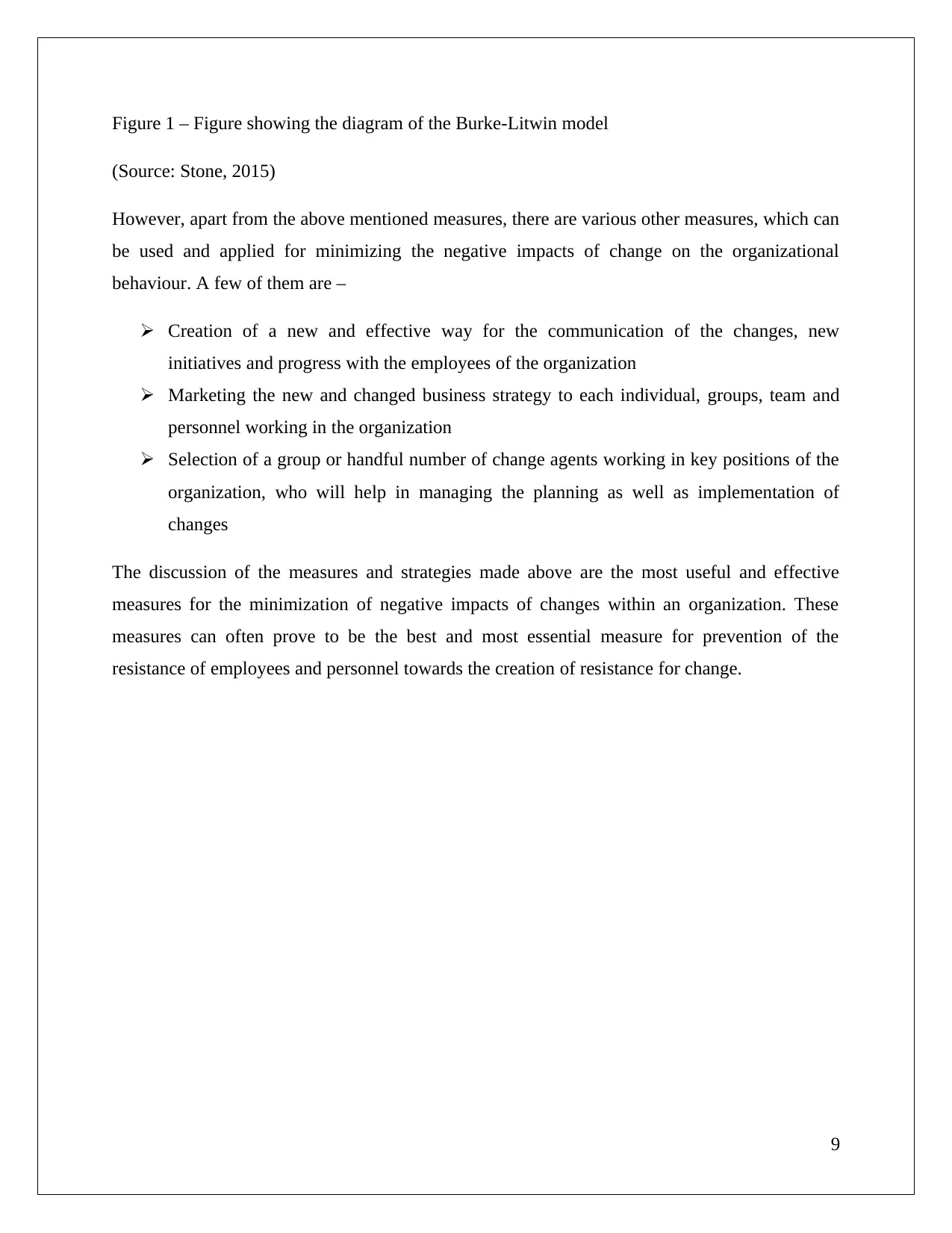
Figure 1 – Figure showing the diagram of the Burke-Litwin model
(Source: Stone, 2015)
However, apart from the above mentioned measures, there are various other measures, which can
be used and applied for minimizing the negative impacts of change on the organizational
behaviour. A few of them are –
Creation of a new and effective way for the communication of the changes, new
initiatives and progress with the employees of the organization
Marketing the new and changed business strategy to each individual, groups, team and
personnel working in the organization
Selection of a group or handful number of change agents working in key positions of the
organization, who will help in managing the planning as well as implementation of
changes
The discussion of the measures and strategies made above are the most useful and effective
measures for the minimization of negative impacts of changes within an organization. These
measures can often prove to be the best and most essential measure for prevention of the
resistance of employees and personnel towards the creation of resistance for change.
9
(Source: Stone, 2015)
However, apart from the above mentioned measures, there are various other measures, which can
be used and applied for minimizing the negative impacts of change on the organizational
behaviour. A few of them are –
Creation of a new and effective way for the communication of the changes, new
initiatives and progress with the employees of the organization
Marketing the new and changed business strategy to each individual, groups, team and
personnel working in the organization
Selection of a group or handful number of change agents working in key positions of the
organization, who will help in managing the planning as well as implementation of
changes
The discussion of the measures and strategies made above are the most useful and effective
measures for the minimization of negative impacts of changes within an organization. These
measures can often prove to be the best and most essential measure for prevention of the
resistance of employees and personnel towards the creation of resistance for change.
9
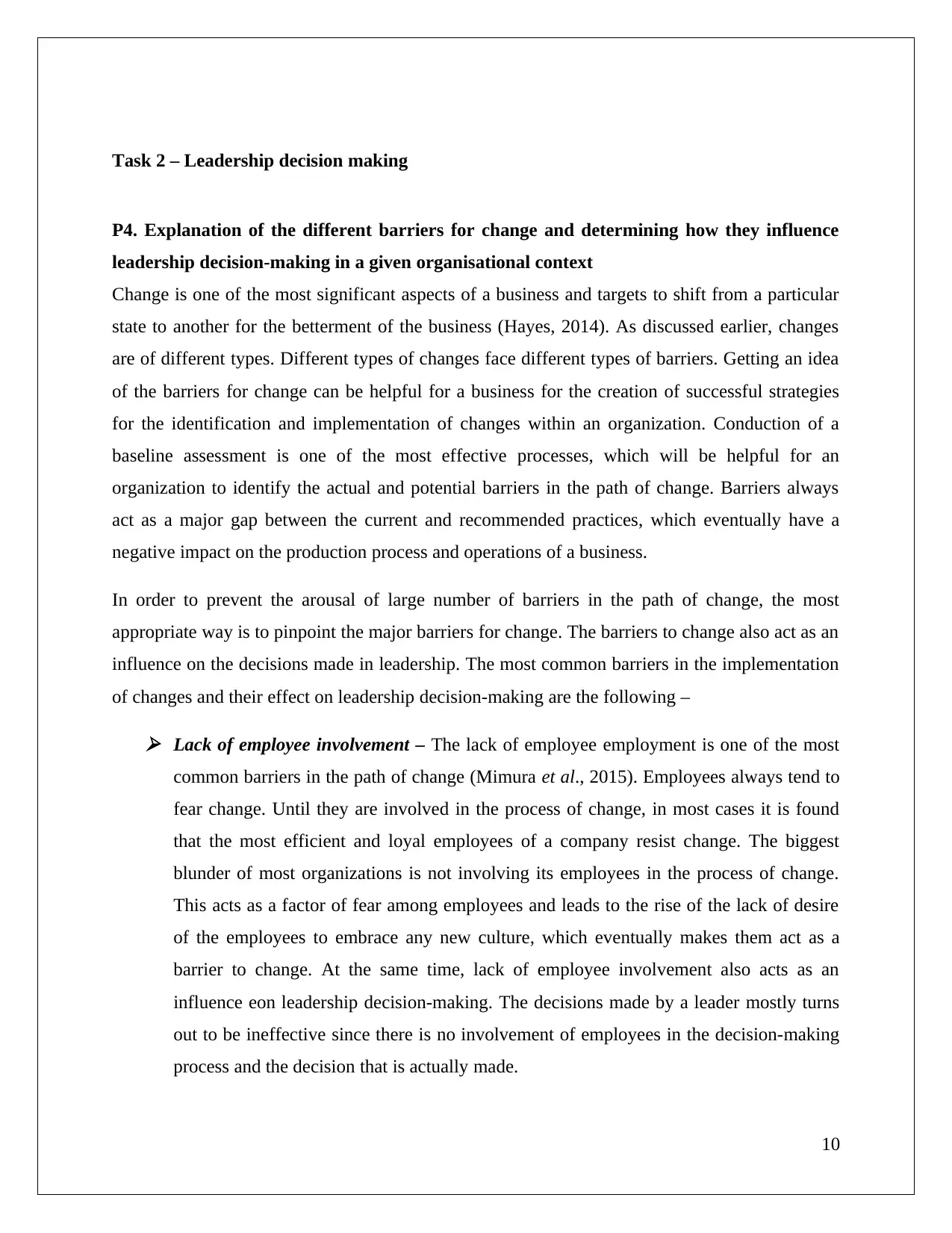
Task 2 – Leadership decision making
P4. Explanation of the different barriers for change and determining how they influence
leadership decision-making in a given organisational context
Change is one of the most significant aspects of a business and targets to shift from a particular
state to another for the betterment of the business (Hayes, 2014). As discussed earlier, changes
are of different types. Different types of changes face different types of barriers. Getting an idea
of the barriers for change can be helpful for a business for the creation of successful strategies
for the identification and implementation of changes within an organization. Conduction of a
baseline assessment is one of the most effective processes, which will be helpful for an
organization to identify the actual and potential barriers in the path of change. Barriers always
act as a major gap between the current and recommended practices, which eventually have a
negative impact on the production process and operations of a business.
In order to prevent the arousal of large number of barriers in the path of change, the most
appropriate way is to pinpoint the major barriers for change. The barriers to change also act as an
influence on the decisions made in leadership. The most common barriers in the implementation
of changes and their effect on leadership decision-making are the following – Lack of employee involvement – The lack of employee employment is one of the most
common barriers in the path of change (Mimura et al., 2015). Employees always tend to
fear change. Until they are involved in the process of change, in most cases it is found
that the most efficient and loyal employees of a company resist change. The biggest
blunder of most organizations is not involving its employees in the process of change.
This acts as a factor of fear among employees and leads to the rise of the lack of desire
of the employees to embrace any new culture, which eventually makes them act as a
barrier to change. At the same time, lack of employee involvement also acts as an
influence eon leadership decision-making. The decisions made by a leader mostly turns
out to be ineffective since there is no involvement of employees in the decision-making
process and the decision that is actually made.
10
P4. Explanation of the different barriers for change and determining how they influence
leadership decision-making in a given organisational context
Change is one of the most significant aspects of a business and targets to shift from a particular
state to another for the betterment of the business (Hayes, 2014). As discussed earlier, changes
are of different types. Different types of changes face different types of barriers. Getting an idea
of the barriers for change can be helpful for a business for the creation of successful strategies
for the identification and implementation of changes within an organization. Conduction of a
baseline assessment is one of the most effective processes, which will be helpful for an
organization to identify the actual and potential barriers in the path of change. Barriers always
act as a major gap between the current and recommended practices, which eventually have a
negative impact on the production process and operations of a business.
In order to prevent the arousal of large number of barriers in the path of change, the most
appropriate way is to pinpoint the major barriers for change. The barriers to change also act as an
influence on the decisions made in leadership. The most common barriers in the implementation
of changes and their effect on leadership decision-making are the following – Lack of employee involvement – The lack of employee employment is one of the most
common barriers in the path of change (Mimura et al., 2015). Employees always tend to
fear change. Until they are involved in the process of change, in most cases it is found
that the most efficient and loyal employees of a company resist change. The biggest
blunder of most organizations is not involving its employees in the process of change.
This acts as a factor of fear among employees and leads to the rise of the lack of desire
of the employees to embrace any new culture, which eventually makes them act as a
barrier to change. At the same time, lack of employee involvement also acts as an
influence eon leadership decision-making. The decisions made by a leader mostly turns
out to be ineffective since there is no involvement of employees in the decision-making
process and the decision that is actually made.
10
Secure Best Marks with AI Grader
Need help grading? Try our AI Grader for instant feedback on your assignments.
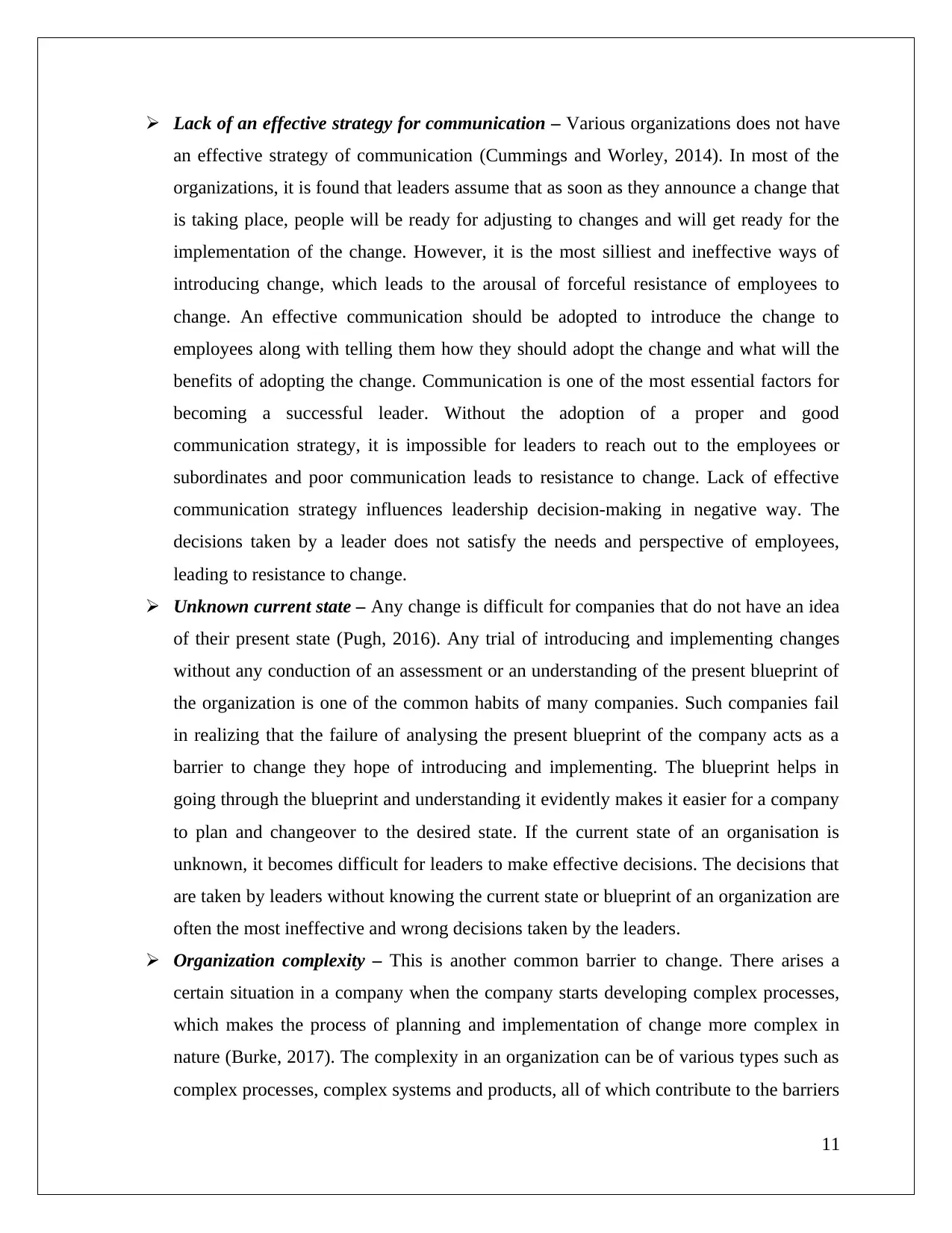
Lack of an effective strategy for communication – Various organizations does not have
an effective strategy of communication (Cummings and Worley, 2014). In most of the
organizations, it is found that leaders assume that as soon as they announce a change that
is taking place, people will be ready for adjusting to changes and will get ready for the
implementation of the change. However, it is the most silliest and ineffective ways of
introducing change, which leads to the arousal of forceful resistance of employees to
change. An effective communication should be adopted to introduce the change to
employees along with telling them how they should adopt the change and what will the
benefits of adopting the change. Communication is one of the most essential factors for
becoming a successful leader. Without the adoption of a proper and good
communication strategy, it is impossible for leaders to reach out to the employees or
subordinates and poor communication leads to resistance to change. Lack of effective
communication strategy influences leadership decision-making in negative way. The
decisions taken by a leader does not satisfy the needs and perspective of employees,
leading to resistance to change.
Unknown current state – Any change is difficult for companies that do not have an idea
of their present state (Pugh, 2016). Any trial of introducing and implementing changes
without any conduction of an assessment or an understanding of the present blueprint of
the organization is one of the common habits of many companies. Such companies fail
in realizing that the failure of analysing the present blueprint of the company acts as a
barrier to change they hope of introducing and implementing. The blueprint helps in
going through the blueprint and understanding it evidently makes it easier for a company
to plan and changeover to the desired state. If the current state of an organisation is
unknown, it becomes difficult for leaders to make effective decisions. The decisions that
are taken by leaders without knowing the current state or blueprint of an organization are
often the most ineffective and wrong decisions taken by the leaders.
Organization complexity – This is another common barrier to change. There arises a
certain situation in a company when the company starts developing complex processes,
which makes the process of planning and implementation of change more complex in
nature (Burke, 2017). The complexity in an organization can be of various types such as
complex processes, complex systems and products, all of which contribute to the barriers
11
an effective strategy of communication (Cummings and Worley, 2014). In most of the
organizations, it is found that leaders assume that as soon as they announce a change that
is taking place, people will be ready for adjusting to changes and will get ready for the
implementation of the change. However, it is the most silliest and ineffective ways of
introducing change, which leads to the arousal of forceful resistance of employees to
change. An effective communication should be adopted to introduce the change to
employees along with telling them how they should adopt the change and what will the
benefits of adopting the change. Communication is one of the most essential factors for
becoming a successful leader. Without the adoption of a proper and good
communication strategy, it is impossible for leaders to reach out to the employees or
subordinates and poor communication leads to resistance to change. Lack of effective
communication strategy influences leadership decision-making in negative way. The
decisions taken by a leader does not satisfy the needs and perspective of employees,
leading to resistance to change.
Unknown current state – Any change is difficult for companies that do not have an idea
of their present state (Pugh, 2016). Any trial of introducing and implementing changes
without any conduction of an assessment or an understanding of the present blueprint of
the organization is one of the common habits of many companies. Such companies fail
in realizing that the failure of analysing the present blueprint of the company acts as a
barrier to change they hope of introducing and implementing. The blueprint helps in
going through the blueprint and understanding it evidently makes it easier for a company
to plan and changeover to the desired state. If the current state of an organisation is
unknown, it becomes difficult for leaders to make effective decisions. The decisions that
are taken by leaders without knowing the current state or blueprint of an organization are
often the most ineffective and wrong decisions taken by the leaders.
Organization complexity – This is another common barrier to change. There arises a
certain situation in a company when the company starts developing complex processes,
which makes the process of planning and implementation of change more complex in
nature (Burke, 2017). The complexity in an organization can be of various types such as
complex processes, complex systems and products, all of which contribute to the barriers
11
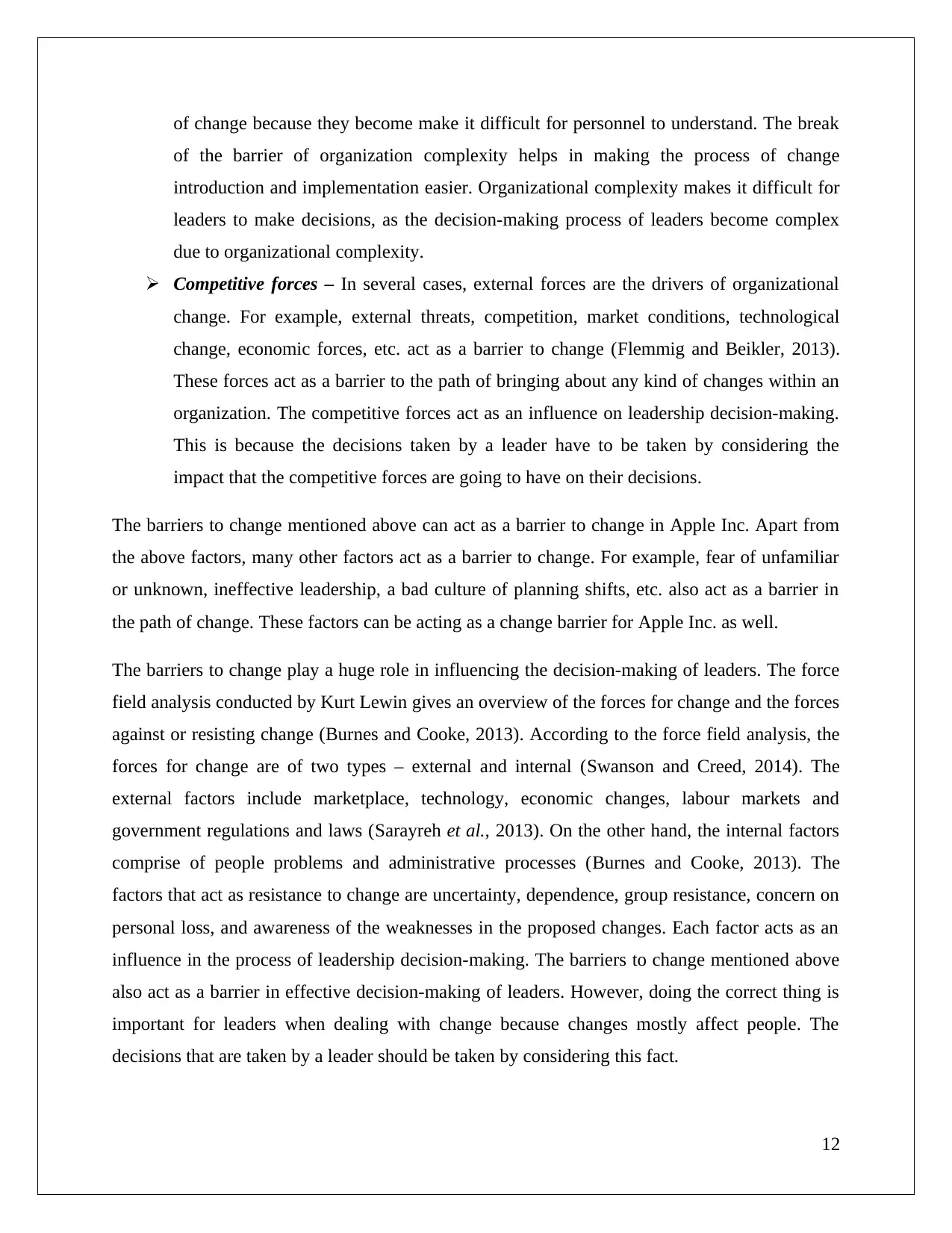
of change because they become make it difficult for personnel to understand. The break
of the barrier of organization complexity helps in making the process of change
introduction and implementation easier. Organizational complexity makes it difficult for
leaders to make decisions, as the decision-making process of leaders become complex
due to organizational complexity.
Competitive forces – In several cases, external forces are the drivers of organizational
change. For example, external threats, competition, market conditions, technological
change, economic forces, etc. act as a barrier to change (Flemmig and Beikler, 2013).
These forces act as a barrier to the path of bringing about any kind of changes within an
organization. The competitive forces act as an influence on leadership decision-making.
This is because the decisions taken by a leader have to be taken by considering the
impact that the competitive forces are going to have on their decisions.
The barriers to change mentioned above can act as a barrier to change in Apple Inc. Apart from
the above factors, many other factors act as a barrier to change. For example, fear of unfamiliar
or unknown, ineffective leadership, a bad culture of planning shifts, etc. also act as a barrier in
the path of change. These factors can be acting as a change barrier for Apple Inc. as well.
The barriers to change play a huge role in influencing the decision-making of leaders. The force
field analysis conducted by Kurt Lewin gives an overview of the forces for change and the forces
against or resisting change (Burnes and Cooke, 2013). According to the force field analysis, the
forces for change are of two types – external and internal (Swanson and Creed, 2014). The
external factors include marketplace, technology, economic changes, labour markets and
government regulations and laws (Sarayreh et al., 2013). On the other hand, the internal factors
comprise of people problems and administrative processes (Burnes and Cooke, 2013). The
factors that act as resistance to change are uncertainty, dependence, group resistance, concern on
personal loss, and awareness of the weaknesses in the proposed changes. Each factor acts as an
influence in the process of leadership decision-making. The barriers to change mentioned above
also act as a barrier in effective decision-making of leaders. However, doing the correct thing is
important for leaders when dealing with change because changes mostly affect people. The
decisions that are taken by a leader should be taken by considering this fact.
12
of the barrier of organization complexity helps in making the process of change
introduction and implementation easier. Organizational complexity makes it difficult for
leaders to make decisions, as the decision-making process of leaders become complex
due to organizational complexity.
Competitive forces – In several cases, external forces are the drivers of organizational
change. For example, external threats, competition, market conditions, technological
change, economic forces, etc. act as a barrier to change (Flemmig and Beikler, 2013).
These forces act as a barrier to the path of bringing about any kind of changes within an
organization. The competitive forces act as an influence on leadership decision-making.
This is because the decisions taken by a leader have to be taken by considering the
impact that the competitive forces are going to have on their decisions.
The barriers to change mentioned above can act as a barrier to change in Apple Inc. Apart from
the above factors, many other factors act as a barrier to change. For example, fear of unfamiliar
or unknown, ineffective leadership, a bad culture of planning shifts, etc. also act as a barrier in
the path of change. These factors can be acting as a change barrier for Apple Inc. as well.
The barriers to change play a huge role in influencing the decision-making of leaders. The force
field analysis conducted by Kurt Lewin gives an overview of the forces for change and the forces
against or resisting change (Burnes and Cooke, 2013). According to the force field analysis, the
forces for change are of two types – external and internal (Swanson and Creed, 2014). The
external factors include marketplace, technology, economic changes, labour markets and
government regulations and laws (Sarayreh et al., 2013). On the other hand, the internal factors
comprise of people problems and administrative processes (Burnes and Cooke, 2013). The
factors that act as resistance to change are uncertainty, dependence, group resistance, concern on
personal loss, and awareness of the weaknesses in the proposed changes. Each factor acts as an
influence in the process of leadership decision-making. The barriers to change mentioned above
also act as a barrier in effective decision-making of leaders. However, doing the correct thing is
important for leaders when dealing with change because changes mostly affect people. The
decisions that are taken by a leader should be taken by considering this fact.
12
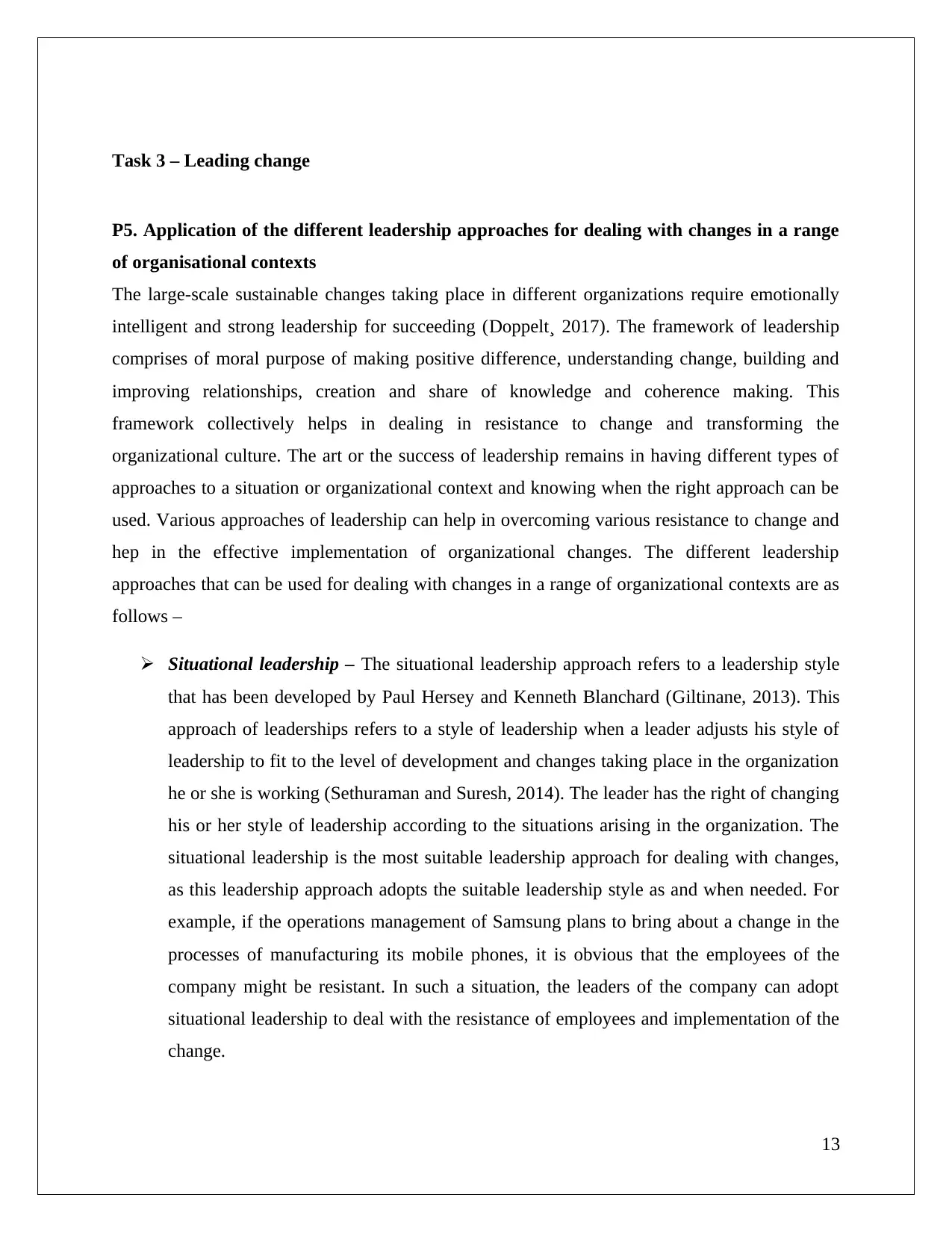
Task 3 – Leading change
P5. Application of the different leadership approaches for dealing with changes in a range
of organisational contexts
The large-scale sustainable changes taking place in different organizations require emotionally
intelligent and strong leadership for succeeding (Doppelt¸ 2017). The framework of leadership
comprises of moral purpose of making positive difference, understanding change, building and
improving relationships, creation and share of knowledge and coherence making. This
framework collectively helps in dealing in resistance to change and transforming the
organizational culture. The art or the success of leadership remains in having different types of
approaches to a situation or organizational context and knowing when the right approach can be
used. Various approaches of leadership can help in overcoming various resistance to change and
hep in the effective implementation of organizational changes. The different leadership
approaches that can be used for dealing with changes in a range of organizational contexts are as
follows –
Situational leadership – The situational leadership approach refers to a leadership style
that has been developed by Paul Hersey and Kenneth Blanchard (Giltinane, 2013). This
approach of leaderships refers to a style of leadership when a leader adjusts his style of
leadership to fit to the level of development and changes taking place in the organization
he or she is working (Sethuraman and Suresh, 2014). The leader has the right of changing
his or her style of leadership according to the situations arising in the organization. The
situational leadership is the most suitable leadership approach for dealing with changes,
as this leadership approach adopts the suitable leadership style as and when needed. For
example, if the operations management of Samsung plans to bring about a change in the
processes of manufacturing its mobile phones, it is obvious that the employees of the
company might be resistant. In such a situation, the leaders of the company can adopt
situational leadership to deal with the resistance of employees and implementation of the
change.
13
P5. Application of the different leadership approaches for dealing with changes in a range
of organisational contexts
The large-scale sustainable changes taking place in different organizations require emotionally
intelligent and strong leadership for succeeding (Doppelt¸ 2017). The framework of leadership
comprises of moral purpose of making positive difference, understanding change, building and
improving relationships, creation and share of knowledge and coherence making. This
framework collectively helps in dealing in resistance to change and transforming the
organizational culture. The art or the success of leadership remains in having different types of
approaches to a situation or organizational context and knowing when the right approach can be
used. Various approaches of leadership can help in overcoming various resistance to change and
hep in the effective implementation of organizational changes. The different leadership
approaches that can be used for dealing with changes in a range of organizational contexts are as
follows –
Situational leadership – The situational leadership approach refers to a leadership style
that has been developed by Paul Hersey and Kenneth Blanchard (Giltinane, 2013). This
approach of leaderships refers to a style of leadership when a leader adjusts his style of
leadership to fit to the level of development and changes taking place in the organization
he or she is working (Sethuraman and Suresh, 2014). The leader has the right of changing
his or her style of leadership according to the situations arising in the organization. The
situational leadership is the most suitable leadership approach for dealing with changes,
as this leadership approach adopts the suitable leadership style as and when needed. For
example, if the operations management of Samsung plans to bring about a change in the
processes of manufacturing its mobile phones, it is obvious that the employees of the
company might be resistant. In such a situation, the leaders of the company can adopt
situational leadership to deal with the resistance of employees and implementation of the
change.
13
Paraphrase This Document
Need a fresh take? Get an instant paraphrase of this document with our AI Paraphraser
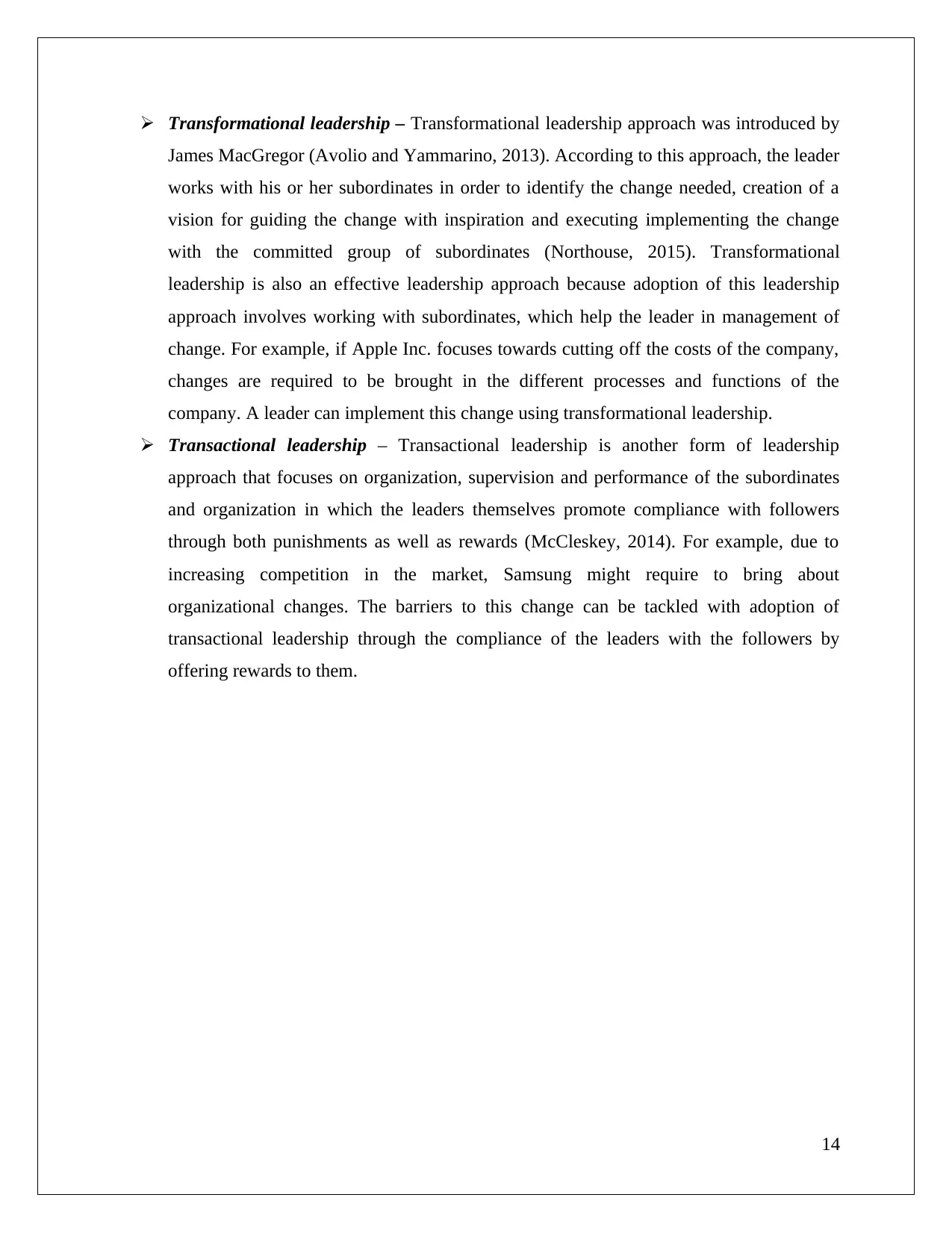
Transformational leadership – Transformational leadership approach was introduced by
James MacGregor (Avolio and Yammarino, 2013). According to this approach, the leader
works with his or her subordinates in order to identify the change needed, creation of a
vision for guiding the change with inspiration and executing implementing the change
with the committed group of subordinates (Northouse, 2015). Transformational
leadership is also an effective leadership approach because adoption of this leadership
approach involves working with subordinates, which help the leader in management of
change. For example, if Apple Inc. focuses towards cutting off the costs of the company,
changes are required to be brought in the different processes and functions of the
company. A leader can implement this change using transformational leadership.
Transactional leadership – Transactional leadership is another form of leadership
approach that focuses on organization, supervision and performance of the subordinates
and organization in which the leaders themselves promote compliance with followers
through both punishments as well as rewards (McCleskey, 2014). For example, due to
increasing competition in the market, Samsung might require to bring about
organizational changes. The barriers to this change can be tackled with adoption of
transactional leadership through the compliance of the leaders with the followers by
offering rewards to them.
14
James MacGregor (Avolio and Yammarino, 2013). According to this approach, the leader
works with his or her subordinates in order to identify the change needed, creation of a
vision for guiding the change with inspiration and executing implementing the change
with the committed group of subordinates (Northouse, 2015). Transformational
leadership is also an effective leadership approach because adoption of this leadership
approach involves working with subordinates, which help the leader in management of
change. For example, if Apple Inc. focuses towards cutting off the costs of the company,
changes are required to be brought in the different processes and functions of the
company. A leader can implement this change using transformational leadership.
Transactional leadership – Transactional leadership is another form of leadership
approach that focuses on organization, supervision and performance of the subordinates
and organization in which the leaders themselves promote compliance with followers
through both punishments as well as rewards (McCleskey, 2014). For example, due to
increasing competition in the market, Samsung might require to bring about
organizational changes. The barriers to this change can be tackled with adoption of
transactional leadership through the compliance of the leaders with the followers by
offering rewards to them.
14
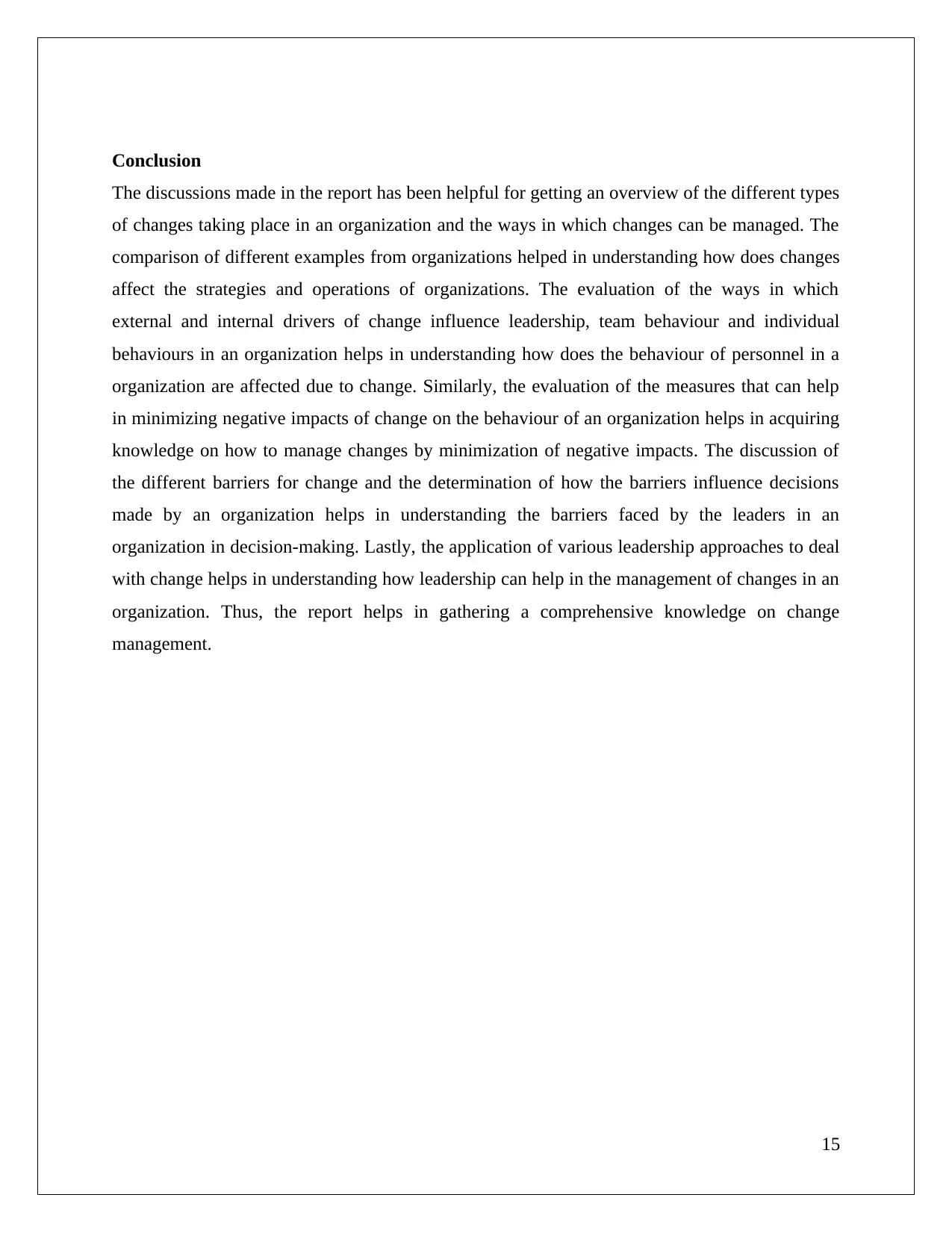
Conclusion
The discussions made in the report has been helpful for getting an overview of the different types
of changes taking place in an organization and the ways in which changes can be managed. The
comparison of different examples from organizations helped in understanding how does changes
affect the strategies and operations of organizations. The evaluation of the ways in which
external and internal drivers of change influence leadership, team behaviour and individual
behaviours in an organization helps in understanding how does the behaviour of personnel in a
organization are affected due to change. Similarly, the evaluation of the measures that can help
in minimizing negative impacts of change on the behaviour of an organization helps in acquiring
knowledge on how to manage changes by minimization of negative impacts. The discussion of
the different barriers for change and the determination of how the barriers influence decisions
made by an organization helps in understanding the barriers faced by the leaders in an
organization in decision-making. Lastly, the application of various leadership approaches to deal
with change helps in understanding how leadership can help in the management of changes in an
organization. Thus, the report helps in gathering a comprehensive knowledge on change
management.
15
The discussions made in the report has been helpful for getting an overview of the different types
of changes taking place in an organization and the ways in which changes can be managed. The
comparison of different examples from organizations helped in understanding how does changes
affect the strategies and operations of organizations. The evaluation of the ways in which
external and internal drivers of change influence leadership, team behaviour and individual
behaviours in an organization helps in understanding how does the behaviour of personnel in a
organization are affected due to change. Similarly, the evaluation of the measures that can help
in minimizing negative impacts of change on the behaviour of an organization helps in acquiring
knowledge on how to manage changes by minimization of negative impacts. The discussion of
the different barriers for change and the determination of how the barriers influence decisions
made by an organization helps in understanding the barriers faced by the leaders in an
organization in decision-making. Lastly, the application of various leadership approaches to deal
with change helps in understanding how leadership can help in the management of changes in an
organization. Thus, the report helps in gathering a comprehensive knowledge on change
management.
15
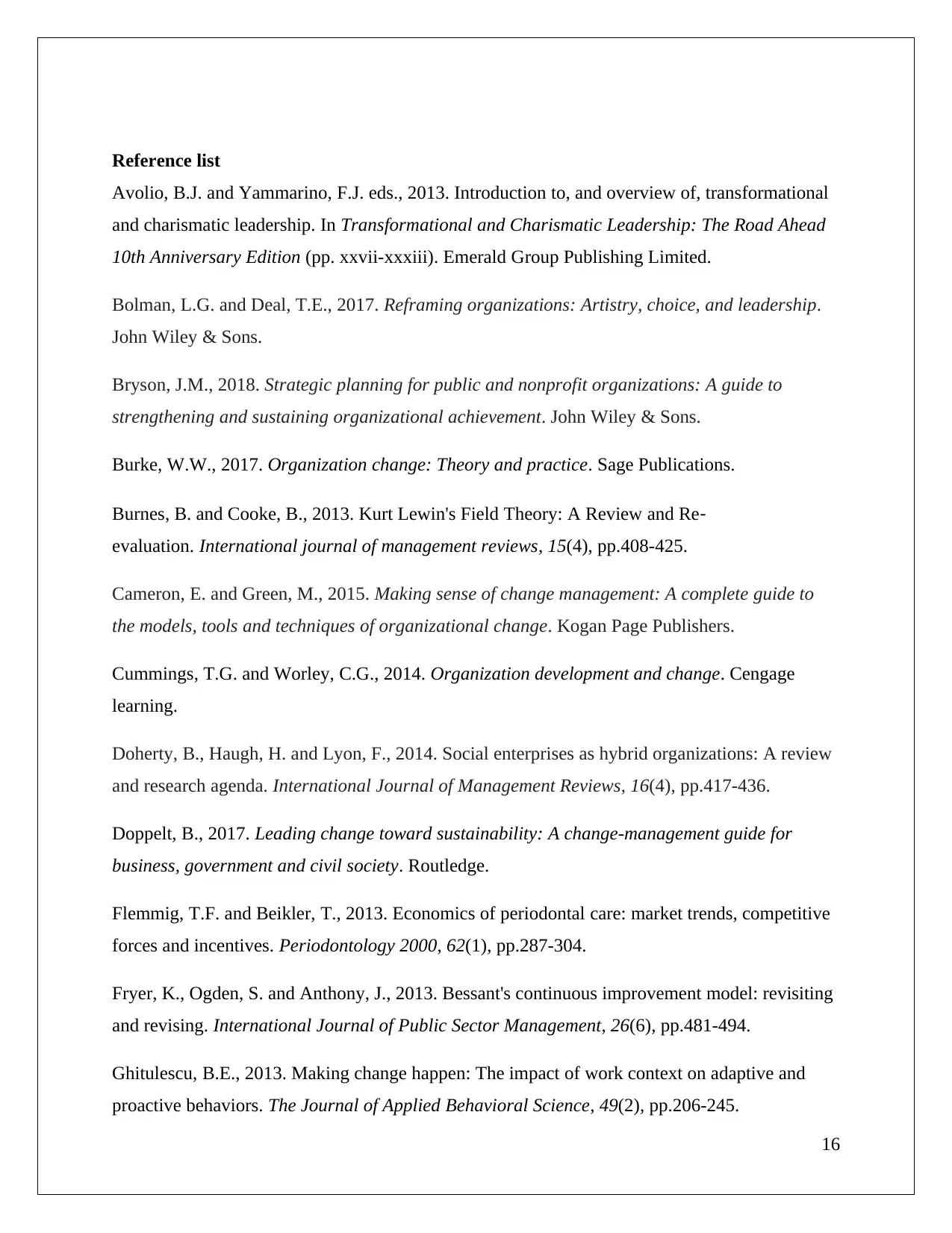
Reference list
Avolio, B.J. and Yammarino, F.J. eds., 2013. Introduction to, and overview of, transformational
and charismatic leadership. In Transformational and Charismatic Leadership: The Road Ahead
10th Anniversary Edition (pp. xxvii-xxxiii). Emerald Group Publishing Limited.
Bolman, L.G. and Deal, T.E., 2017. Reframing organizations: Artistry, choice, and leadership.
John Wiley & Sons.
Bryson, J.M., 2018. Strategic planning for public and nonprofit organizations: A guide to
strengthening and sustaining organizational achievement. John Wiley & Sons.
Burke, W.W., 2017. Organization change: Theory and practice. Sage Publications.
Burnes, B. and Cooke, B., 2013. Kurt Lewin's Field Theory: A Review and Re‐
evaluation. International journal of management reviews, 15(4), pp.408-425.
Cameron, E. and Green, M., 2015. Making sense of change management: A complete guide to
the models, tools and techniques of organizational change. Kogan Page Publishers.
Cummings, T.G. and Worley, C.G., 2014. Organization development and change. Cengage
learning.
Doherty, B., Haugh, H. and Lyon, F., 2014. Social enterprises as hybrid organizations: A review
and research agenda. International Journal of Management Reviews, 16(4), pp.417-436.
Doppelt, B., 2017. Leading change toward sustainability: A change-management guide for
business, government and civil society. Routledge.
Flemmig, T.F. and Beikler, T., 2013. Economics of periodontal care: market trends, competitive
forces and incentives. Periodontology 2000, 62(1), pp.287-304.
Fryer, K., Ogden, S. and Anthony, J., 2013. Bessant's continuous improvement model: revisiting
and revising. International Journal of Public Sector Management, 26(6), pp.481-494.
Ghitulescu, B.E., 2013. Making change happen: The impact of work context on adaptive and
proactive behaviors. The Journal of Applied Behavioral Science, 49(2), pp.206-245.
16
Avolio, B.J. and Yammarino, F.J. eds., 2013. Introduction to, and overview of, transformational
and charismatic leadership. In Transformational and Charismatic Leadership: The Road Ahead
10th Anniversary Edition (pp. xxvii-xxxiii). Emerald Group Publishing Limited.
Bolman, L.G. and Deal, T.E., 2017. Reframing organizations: Artistry, choice, and leadership.
John Wiley & Sons.
Bryson, J.M., 2018. Strategic planning for public and nonprofit organizations: A guide to
strengthening and sustaining organizational achievement. John Wiley & Sons.
Burke, W.W., 2017. Organization change: Theory and practice. Sage Publications.
Burnes, B. and Cooke, B., 2013. Kurt Lewin's Field Theory: A Review and Re‐
evaluation. International journal of management reviews, 15(4), pp.408-425.
Cameron, E. and Green, M., 2015. Making sense of change management: A complete guide to
the models, tools and techniques of organizational change. Kogan Page Publishers.
Cummings, T.G. and Worley, C.G., 2014. Organization development and change. Cengage
learning.
Doherty, B., Haugh, H. and Lyon, F., 2014. Social enterprises as hybrid organizations: A review
and research agenda. International Journal of Management Reviews, 16(4), pp.417-436.
Doppelt, B., 2017. Leading change toward sustainability: A change-management guide for
business, government and civil society. Routledge.
Flemmig, T.F. and Beikler, T., 2013. Economics of periodontal care: market trends, competitive
forces and incentives. Periodontology 2000, 62(1), pp.287-304.
Fryer, K., Ogden, S. and Anthony, J., 2013. Bessant's continuous improvement model: revisiting
and revising. International Journal of Public Sector Management, 26(6), pp.481-494.
Ghitulescu, B.E., 2013. Making change happen: The impact of work context on adaptive and
proactive behaviors. The Journal of Applied Behavioral Science, 49(2), pp.206-245.
16
Secure Best Marks with AI Grader
Need help grading? Try our AI Grader for instant feedback on your assignments.
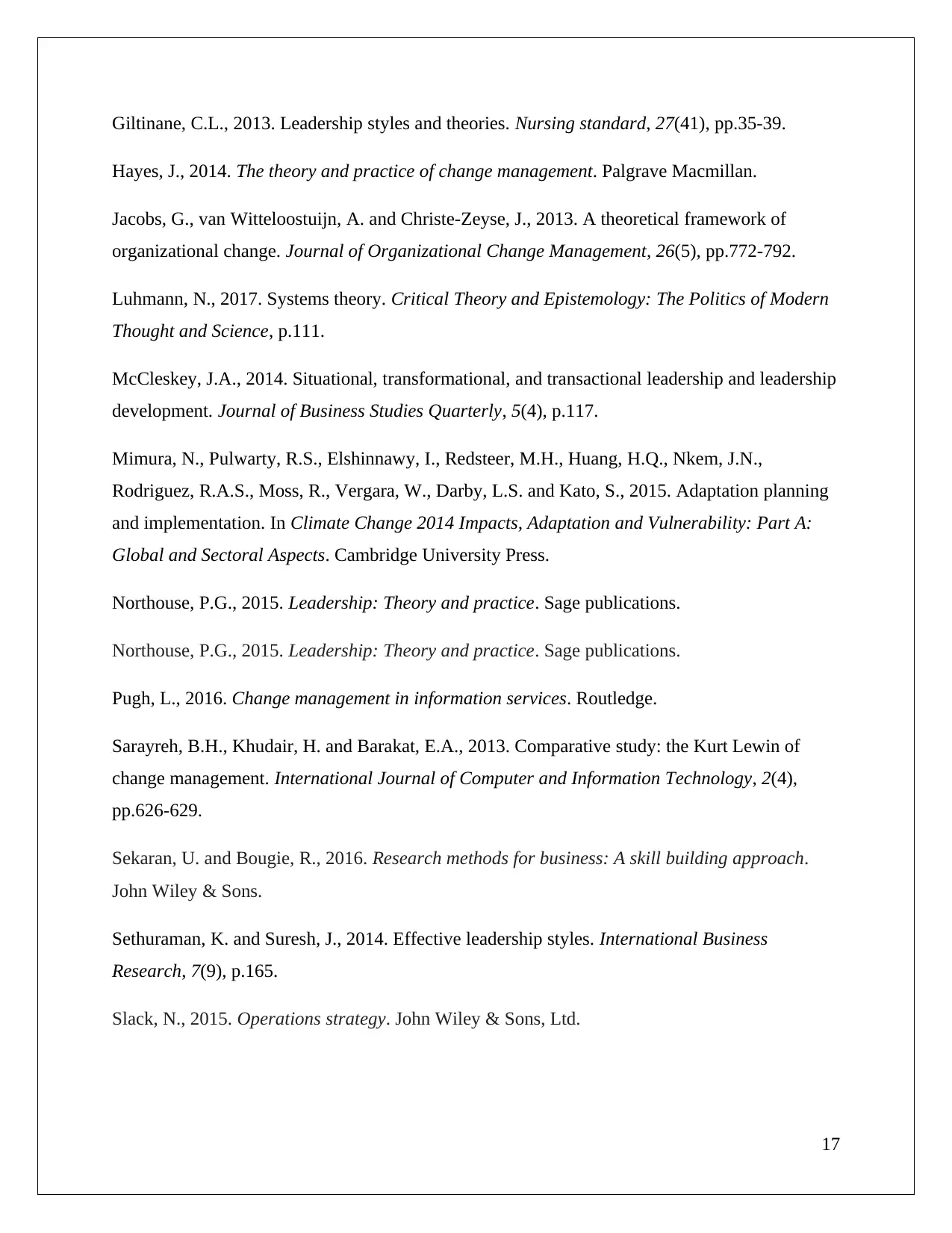
Giltinane, C.L., 2013. Leadership styles and theories. Nursing standard, 27(41), pp.35-39.
Hayes, J., 2014. The theory and practice of change management. Palgrave Macmillan.
Jacobs, G., van Witteloostuijn, A. and Christe-Zeyse, J., 2013. A theoretical framework of
organizational change. Journal of Organizational Change Management, 26(5), pp.772-792.
Luhmann, N., 2017. Systems theory. Critical Theory and Epistemology: The Politics of Modern
Thought and Science, p.111.
McCleskey, J.A., 2014. Situational, transformational, and transactional leadership and leadership
development. Journal of Business Studies Quarterly, 5(4), p.117.
Mimura, N., Pulwarty, R.S., Elshinnawy, I., Redsteer, M.H., Huang, H.Q., Nkem, J.N.,
Rodriguez, R.A.S., Moss, R., Vergara, W., Darby, L.S. and Kato, S., 2015. Adaptation planning
and implementation. In Climate Change 2014 Impacts, Adaptation and Vulnerability: Part A:
Global and Sectoral Aspects. Cambridge University Press.
Northouse, P.G., 2015. Leadership: Theory and practice. Sage publications.
Northouse, P.G., 2015. Leadership: Theory and practice. Sage publications.
Pugh, L., 2016. Change management in information services. Routledge.
Sarayreh, B.H., Khudair, H. and Barakat, E.A., 2013. Comparative study: the Kurt Lewin of
change management. International Journal of Computer and Information Technology, 2(4),
pp.626-629.
Sekaran, U. and Bougie, R., 2016. Research methods for business: A skill building approach.
John Wiley & Sons.
Sethuraman, K. and Suresh, J., 2014. Effective leadership styles. International Business
Research, 7(9), p.165.
Slack, N., 2015. Operations strategy. John Wiley & Sons, Ltd.
17
Hayes, J., 2014. The theory and practice of change management. Palgrave Macmillan.
Jacobs, G., van Witteloostuijn, A. and Christe-Zeyse, J., 2013. A theoretical framework of
organizational change. Journal of Organizational Change Management, 26(5), pp.772-792.
Luhmann, N., 2017. Systems theory. Critical Theory and Epistemology: The Politics of Modern
Thought and Science, p.111.
McCleskey, J.A., 2014. Situational, transformational, and transactional leadership and leadership
development. Journal of Business Studies Quarterly, 5(4), p.117.
Mimura, N., Pulwarty, R.S., Elshinnawy, I., Redsteer, M.H., Huang, H.Q., Nkem, J.N.,
Rodriguez, R.A.S., Moss, R., Vergara, W., Darby, L.S. and Kato, S., 2015. Adaptation planning
and implementation. In Climate Change 2014 Impacts, Adaptation and Vulnerability: Part A:
Global and Sectoral Aspects. Cambridge University Press.
Northouse, P.G., 2015. Leadership: Theory and practice. Sage publications.
Northouse, P.G., 2015. Leadership: Theory and practice. Sage publications.
Pugh, L., 2016. Change management in information services. Routledge.
Sarayreh, B.H., Khudair, H. and Barakat, E.A., 2013. Comparative study: the Kurt Lewin of
change management. International Journal of Computer and Information Technology, 2(4),
pp.626-629.
Sekaran, U. and Bougie, R., 2016. Research methods for business: A skill building approach.
John Wiley & Sons.
Sethuraman, K. and Suresh, J., 2014. Effective leadership styles. International Business
Research, 7(9), p.165.
Slack, N., 2015. Operations strategy. John Wiley & Sons, Ltd.
17
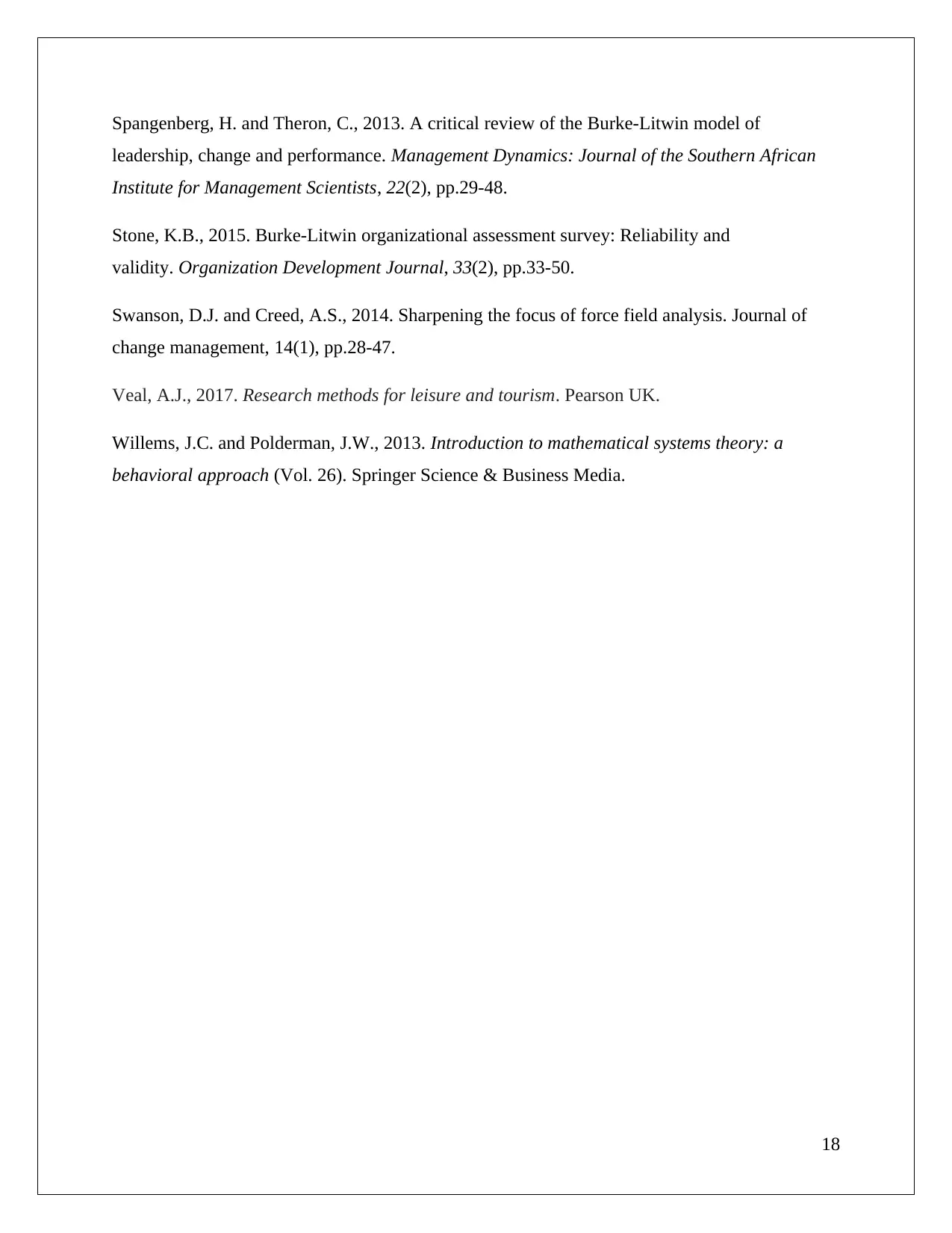
Spangenberg, H. and Theron, C., 2013. A critical review of the Burke-Litwin model of
leadership, change and performance. Management Dynamics: Journal of the Southern African
Institute for Management Scientists, 22(2), pp.29-48.
Stone, K.B., 2015. Burke-Litwin organizational assessment survey: Reliability and
validity. Organization Development Journal, 33(2), pp.33-50.
Swanson, D.J. and Creed, A.S., 2014. Sharpening the focus of force field analysis. Journal of
change management, 14(1), pp.28-47.
Veal, A.J., 2017. Research methods for leisure and tourism. Pearson UK.
Willems, J.C. and Polderman, J.W., 2013. Introduction to mathematical systems theory: a
behavioral approach (Vol. 26). Springer Science & Business Media.
18
leadership, change and performance. Management Dynamics: Journal of the Southern African
Institute for Management Scientists, 22(2), pp.29-48.
Stone, K.B., 2015. Burke-Litwin organizational assessment survey: Reliability and
validity. Organization Development Journal, 33(2), pp.33-50.
Swanson, D.J. and Creed, A.S., 2014. Sharpening the focus of force field analysis. Journal of
change management, 14(1), pp.28-47.
Veal, A.J., 2017. Research methods for leisure and tourism. Pearson UK.
Willems, J.C. and Polderman, J.W., 2013. Introduction to mathematical systems theory: a
behavioral approach (Vol. 26). Springer Science & Business Media.
18
1 out of 18
Related Documents
Your All-in-One AI-Powered Toolkit for Academic Success.
+13062052269
info@desklib.com
Available 24*7 on WhatsApp / Email
![[object Object]](/_next/static/media/star-bottom.7253800d.svg)
Unlock your academic potential
© 2024 | Zucol Services PVT LTD | All rights reserved.





